Inside Kyoto
A Kyoto Travel Guide

Arashiyama Bamboo Grove Walking Tour
The Arashiyama Bamboo Grove is one of Japan’s most incredible sights. Our walking tour route allows you to enjoy the Bamboo Grove and the surrounding sights while avoiding the worst of the crowds.

Arashiyama Bamboo Grove Introduction
Located about 7km west of downtown Kyoto, Arashiyama is one of Kyoto’s most popular sightseeing districts. The heart of the district is the Arashiyama Bamboo Grove, a mesmerizing grove of thousands of tall bamboo plants. A paved walkway runs through the middle of both sections, forming the famous “Bamboo Alley,” one of Kyoto’s most photographed sights.

It was possible to have the entire place to yourself just a few years ago. Now, if you go during high season, you’ll find almost as many selfie sticks as bamboo stalks. Luckily, the crowds tend to thin out as you make your way away from the main street of Arashiyama. Our walking tour below is designed to get you away from the crowds as quickly as possible.
Check Hotel Availability
Destination, check-in date, check-out date.

About the Arashiyama Bamboo Grove
The Arashiyama Bamboo Grove is really two separate bamboo groves, both of which are sandwiched between Tenryu-ji Temple grounds and the JR Sagano-Saiin line train tracks. The combined length is about 500 meters, and the grove is about 140 meters wide. In the middle of the eastern section, near the main street, you’ll find Nonomiya-jinja Shrine, a popular Shinto Shrine, while on the southern edge of the western section, you’ll find the beautiful gardens and halls of Tenryu-ji Temple, one of Kyoto’s most beautiful Buddhist temples.

Many people wonder about the meaning or purpose of the bamboo grove. As a matter of fact, it’s merely decorative. Arashiyama has been a favorite location of imperial and noble villas and temples from the days of classical Japan (the Heian Period). Bamboo was a popular element in the gardens of these villas. During the Edo Period, bamboo was cultivated in the area for use in many Japanese crafts, as well as for eating (bamboo shoots are a popular ingredient in Japanese food). Due to economic changes in the modern era, many bamboo groves in Arashiyama were abandoned or turned into residential areas. However, the government acted in in 1967 to protect the remaining bamboo groves, so that today we can enjoy the fantastic grove we see today.

Arashiyama Bamboo Grove Walking Tour Route
While it’s possible to enter the Bamboo Grove directly from the main street of Arashiyama, we find that the first section is always too crowded. Thus, in the following route, you will enter via the north exit of Tenryu-ji Temple. This allows you to enjoy the temple and also skip the worst of the crowds. After traversing the best part of the Bamboo Grove, you’ll visit Okochi-Sanso Villa and then enter Kameyama-koen Park, before descending to the Katsura-gawa River and walking downstream back to the main street of Arashiyama.

This walk can be done in about an hour if you walk non-stop. If you slow down and enjoy the sights along the way, plan on three or four hours. Hint: the restaurants are usually pretty busy in Arashiyama, so consider picking up some picnic supplies at a bakery or convenience store before heading out to Arashiyama and eating them in Kameyama-koen Park (along the route). For transport directions to Arashiyama, see our main Arashiyama page .
The route and the sights mentioned here are all shown on the map at the end of this page.
Arashiyama Benkei

Start your walk from the main street of Arashiyama near Keifuku Arashiyama Station. Walk north (away from the river). You will soon see the main entrance to Tenryu-ji Temple on the left. Enter through this entrance.

If you missed the main entrance, there is another entrance just a bit further along. They both go to the same place.

Walk toward the temple (in the direction of the mountains). You will soon come to a sign for the temple and the ticket booth. Continue straight toward the temple.

The next sign indicates the choice between visiting the garden and visiting the main hall of the temple. We recommend visiting the garden only, so take a left here.

Buy your ticket at the ticket booth and enter the garden. The garden here is one of the best in Kyoto, so take your time to enjoy it before continuing.

Make your way past the pond and work your way uphill toward the Tahoden Hall. Just beyond this, you will see the North Exit of the temple.

Exit the temple via the North Exit. You will find yourself at the bottom of the western section of the Arashiyama Bamboo Grove. Take a left and walk uphill.

Walk uphill through the famous “Bamboo Alley.”

When you reach the top of the slope, look to the right and you will see entrance to Okochi-Sanso Villa diagonally across from you. This superb villa and garden is well worth a visit. Be sure to hold onto your ticket as it will get you a cup of matcha tea and a sweet after you explore the garden.

Here’s a picture of the sign at the entrance to Okochi-Sanso Villa.

We recommend following the full route through the garden at Okochi-Sanso. It’s clearly marked with signs. Then, make your way to the tearoom area when you’re done for a nice break.

When you have finished your tea break, exit the villa the way you came in. Take a right at the bottom of the slope and walk south (toward the open park area). This will bring you to the entrance to Kameyama-koen Park.

Shortly after entering the park, take the cobblestone path uphill. Keep walking until you reach the summit of the park.

There is a viewing area at the summit of the park that affords excellent views of the Arashiyama Mountains and down to the Hozu-gawa River (the name of the river changes to the Katsura-gawa just downstream from here).

Now, walk downhill, sticking to the pathways on your right (the southern edge of the park).

You will soon come to a narrow footpath branching off on your right. Take this path.

The path descends some cobblestone steps.

Keep heading downhill, sticking to the right. You will soon pass the wooden sign for Shorai-an, a traditional tofu restaurant. The river will also appear through the trees at this point. Head down the paths to the river.

You’ll soon arrive at the pleasant, flat walkway along the Katsura-gawa River. Take a left and follow it downstream.

A few hundred meters of walking along the river will bring you back to the heart of Arashiyama and the main road. To the left is Keifuku Arashiyama Station, to the right, across the Togetsu-kyo Bridge, is Hankyu Arashiyama Station.

Arashiyama Bamboo Grove Walking Tour Map
All the sites mentioned here are on this map. The map also shows the walking tour route described above:
View a full-sized version of the Arashiyama map.
Places to Stay and Eat in Arashiyama
For our recommended restaurants and accommodations in Arashiyama, check out our main Arashiyama page .

Kyoto Walking Tour: Arashiyama
Kyoto vacation checklist.
- For all the essentials in a brief overview, see my First Time In Kyoto guide
- Check Kyoto accommodation availability on Booking.com and Agoda.com - often you can book with no upfront payment and free cancellation
- You can buy shinkansen (bullet train) tickets online from Klook - popular routes include Tokyo to Kyoto , Kyoto to Osaka and Kyoto to Tokyo
- Need tips on where to stay? See my one page guide Where To Stay In Kyoto
- See my comprehensive Packing List For Japan
- Buy a data-only SIM card online for collection when you arrive at Kansai International Airport (for Osaka and Kyoto) or Tokyo's Narita Airport . Or rent an unlimited data pocket wifi router
- Compare Japan flight prices and timings to find the best deals
- If you're making frequent train journeys during your visit, you might save money with Japan Rail Pass – see if it's worth it for you
- A prepaid Welcome Suica card makes travelling around Kyoto easy – here's how
- World Nomads offers simple and flexible travel insurance. Buy at home or while traveling and claim online from anywhere in the world
Kyoto District Map

- Central Kyoto
- Northwest Kyoto
- Northern Higashiyama
- Southern Higashiyama
- Downtown Kyoto
- Kyoto Station Area
- South East Kyoto
Disclosure: InsideKyoto.com is a participant in the Amazon Services LLC Associates Program, an affiliate advertising program designed to provide a means for sites to earn advertising fees by advertising and linking to amazon.com and amazon.co.uk. World Nomads provides travel insurance for travellers in over 100 countries. As an affiliate, we receive a fee when you get a quote from World Nomads using this link. We do not represent World Nomads. This is information only and not a recommendation to buy travel insurance.
- Destinations
14 Amazing THINGS to DO in ARASHIYAMA, Kyoto (Map+Useful Tips)
This site uses affiliate links, meaning that if you make a purchase through our links, we may earn an affiliate commission.
Arashiyama is a beautiful area located on the western outskirts of Kyoto . A visit to Arashiyama can be overwhelming as there is so much to see. Here is a handy list of 14 amazing things to do in Arashiyma to make your visit fun and memorable!
Are you planning any more day trips from Kyoto? How about Miyajima Island, the island of the Gods? Check out: Perfect Day Trip to Miyajima from Kyoto, Osaka, or Hiroshima .
And now, with no further delay here are all the details on how to get to Arashiyama and the amazing 14 things to do in Arashiyama :
14 Amazing Things to Do in Arashiyama
Learn More About Kyoto:
Stunning Golden Pavilion in Kyoto (How to Visit and What to See)
What to See at Nijo Castle in Kyoto (10 Top Things to Know)
Amazing Fushimi Inari Taisha in Kyoto (8 Things to Know Before You Visit)
Perfect ONE DAY in KANAZAWA – 7 Things to Do (BEST TRIP from Tokyo, Kyoto, or Osaka)
You Might Also Like:
7 Fun and Easy DAY TRIPS from KYOTO (Useful Maps+Photos+Tips)
Discover 6 JAPANESE TEA CEREMONY STEPS for a Meaningful Experience
Ultimate 16-DAY JAPAN ITINERARY for Marvelous Culture, History, and Nature
- 1. Where Is Arashiyma Located and How to Get to Arashiyama from Kyoto
- 2. Map of Arashiyama
- 3. 14 Amazing Things to Do in Arashiyama
- 3.1. Take a Walk Through Arashiyama Bamboo Grove
- 3.2. Go for a Rickshaw Ride Through Arashiyama
- 3.3. Take a Walk Across Togetsukyo Bridge
- 3.4. Visit Iwatayama Monkey Park in Arashiyama
- 3.5. Visit Tenryuji Temple in Arashiyama
- 3.6. Stop by Nonomiya-jinja Shrine
- 3.7. Take a Tour of Okochi Sanso Villa and Garden
- 3.8. Explore Jojakkoji Temple in Arashiyama
- 3.9. Head to Adashino Nenbutsuji Temple
- 3.10. Take a Stroll Along Saga Toriimoto Preserved Street
- 3.11. Take a Ride on Sagano Romantic Train
- 3.12. Join Arashiyama Cormorant Fishing Tour
- 3.13. Attend Arashiyama Hanatouro Illumination Festival
- 3.14. Go on Hozugawa River Boat Ride
- 4. Intrepid Scout's Tips for Things to Do in Arashiyama
Where Is Arashiyma Located and How to Get to Arashiyama from Kyoto
Arashiyama ( Storm Mountain ) is a district located on the western outskirts of Kyoto, Japan.
There are several options for getting to Arashiyama from Kyoto.
- First of all, you can take Kyoto Bus #72 or #73 (Bus Stop C-6) from Kyoto Station and get off at Arashiyama. The cost of the bus ticket is 230 yen.
- Or, you can take the local JR Train from Kyoto Station to Arashiyama, specifically, to Saga Arashiyma Station . The journey time is 10-15 minutes depending on whether you get a rapid train or not. The cost of the train ticket is 240 yen.
If you have a JR Pass , then the cost of your ticket will be covered by the pass. You can purchase JR Pass here .
Map of Arashiyama
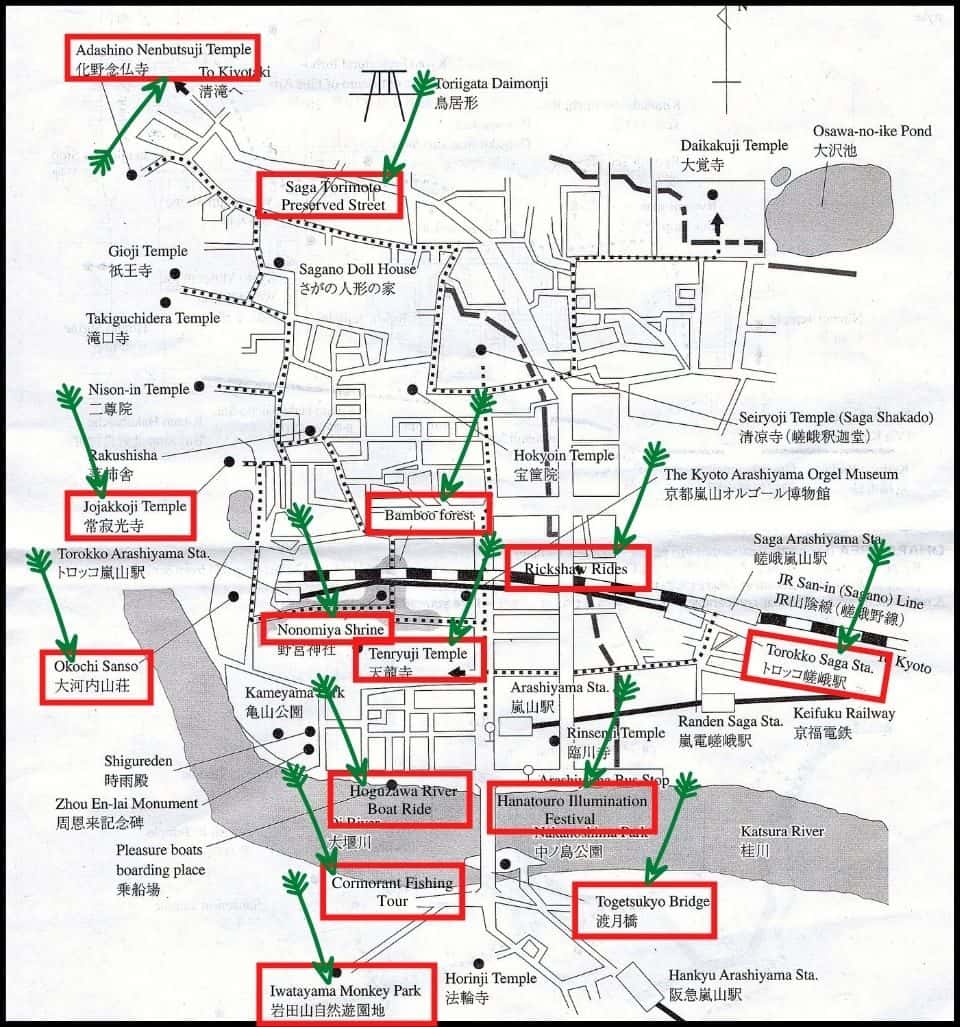
Map of Arashiyama / Image Credit: Japan National Tourism Organization / Things to Do in Arashiyama
To Print the Map of 14 Things to Do in Arashiyama
Click: HERE
14 Amazing Things to Do in Arashiyama
Take a walk through arashiyama bamboo grove.
Hands down, one of the top things to do in Arashiyama is to take a walk through Arashiyama Bamboo Grove .
Arashiyama Bamboo Grove is a beautiful and peaceful bamboo forest. It looks absolutely amazing if there is a bit of sunlight filtering through the tall bamboo trees or if there is some light breeze that will make the stalks gently sway and let in the dappled light.
If you like photography, then this is the place to go! You will have a lot of fun taking pictures of this place.
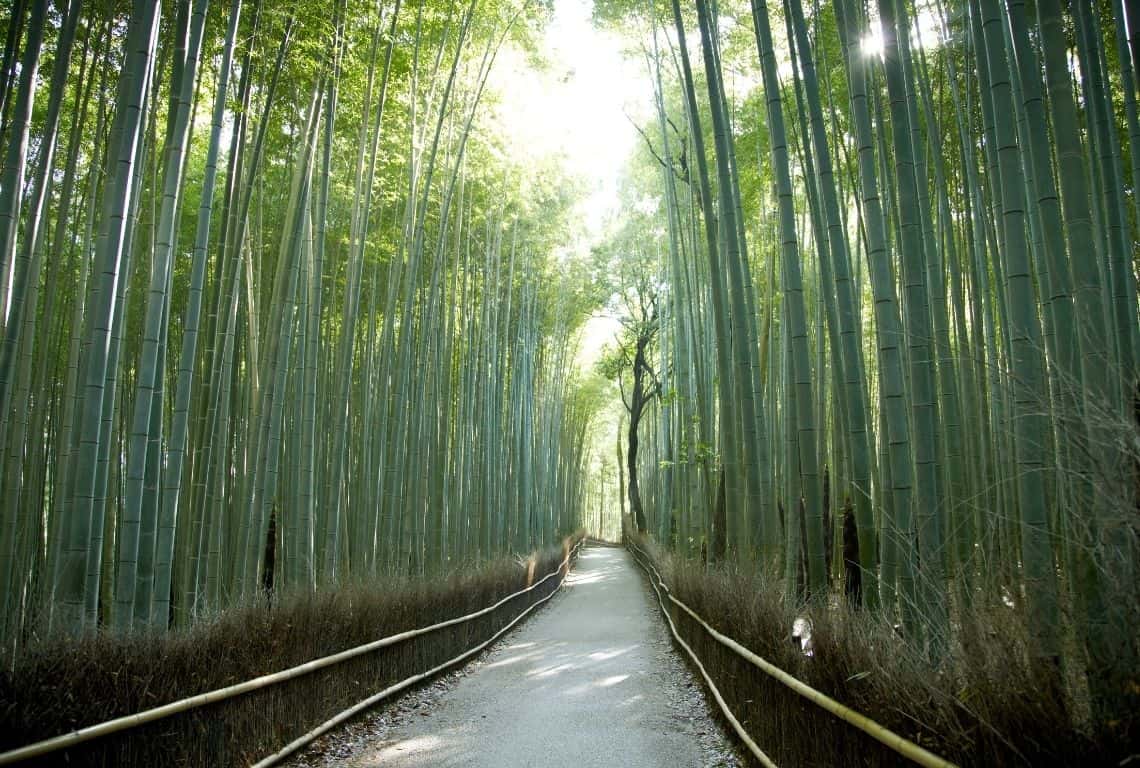
Take a Walk Through Arashiyama Bamboo Grove / Things to Do in Arashiyama
Things to Do in Arashiyama
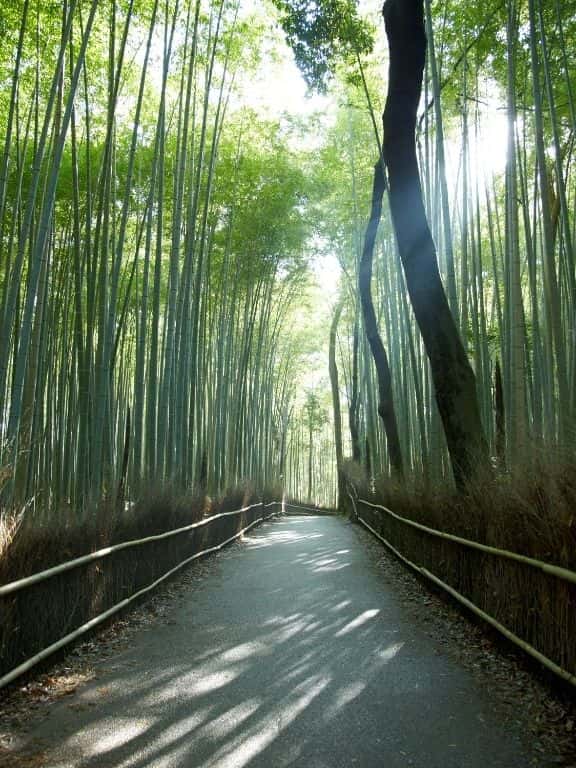
What you need to know is that Arashiyama Bamboo Grove is a very popular place! You will have a lot of company everywhere you go and it is almost impossible to get any pictures without tourists in them.
So, to get the best pictures, head to Arashiyama Bamboo Grove early in the morning. You will avoid the large crowds of tourists that swarm this place starting at about 9 or 10 am (especially on the weekends) and you will have the place pretty much to yourself.
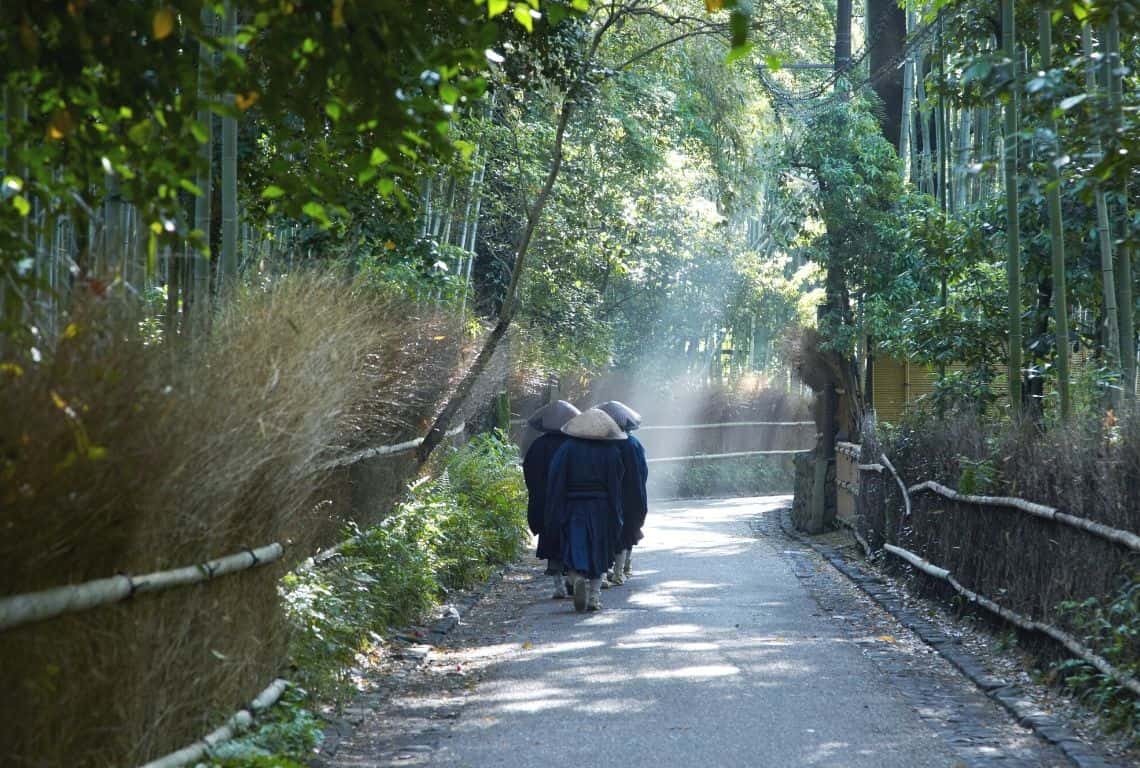
It is super easy to get to Arashiyama Bamboo Grove from JR Saga Arashiyama Station. Once you exit the station, turn right and proceed towards the grove.
It is no more than a 10-15 minute walk from the train station.
The nice thing about Arashiyama Bamboo Grove is that it is completely free and you can visit at any time.
Go for a Rickshaw Ride Through Arashiyama
Ok, you cannot miss a rickshaw ride in Arashiyama ! It is so much fun and trust me, you will love it!
My recommendation is to book an Arashiyama Rickshaw Tour . This tour will take you through Bamboo Grove and some of the most scenic and historic districts in Arashiyama.
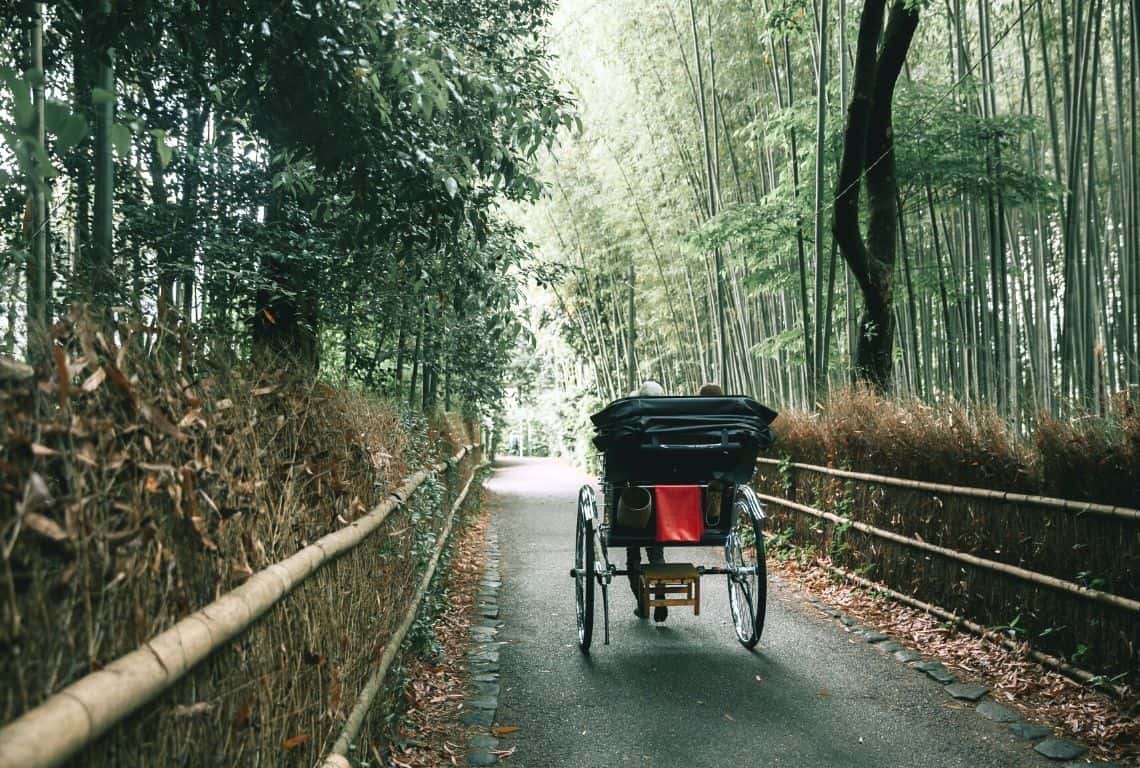
Go for a Rickshaw Ride Through Arashiyama / Things to Do in Arashiyama
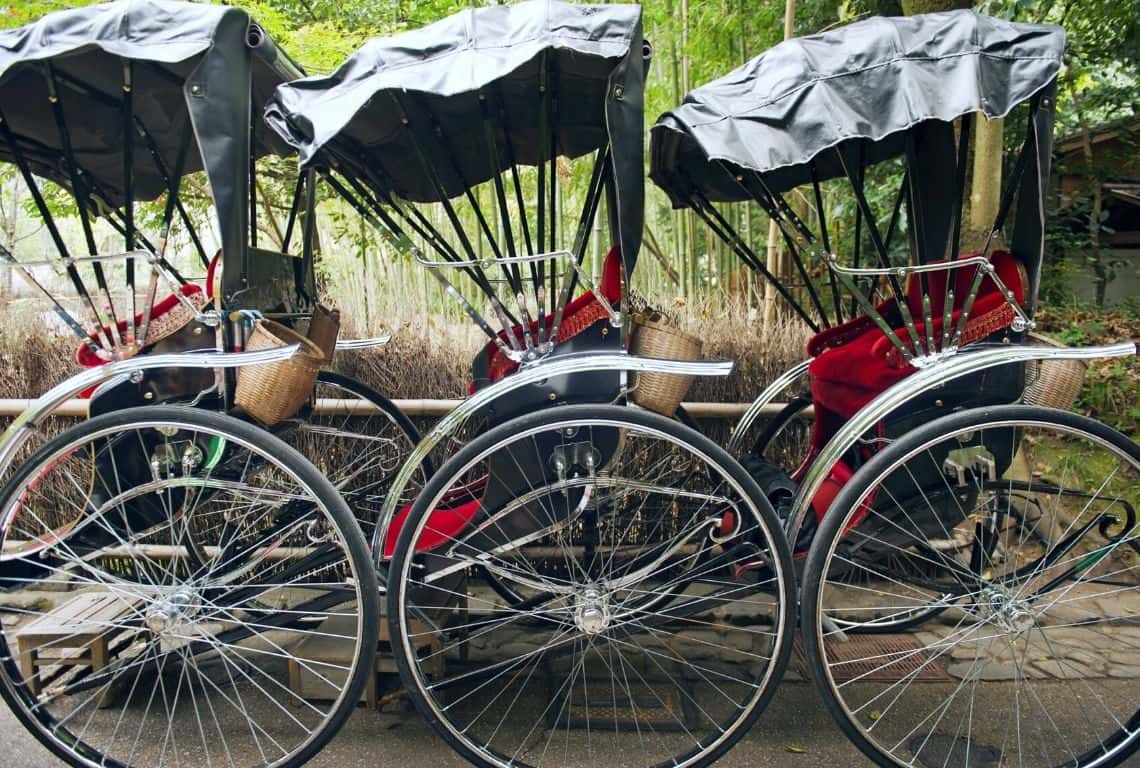
Take a Walk Across Togetsukyo Bridge
Arashiyama’s most iconic landmark is the wooden Togetsukyo Bridge . It is located no more than 10-15 minutes going south of Bamboo Grove.
Some sources claim that the Togetsukyo bridge spans the Katsura River . And, some sources say that it goes over the Oi River .
So, to clarify, the river is referred to as the Oi River until it reaches Togetsukyo Bridge. After it passes under the bridge, it is referred to as the Katsura River.
It is believed that the bridge was built in 836 AD when the priest Dosho (a disciple of Kobo Daishi , founder of the Shingon sect of Buddhism ) was conducting construction work along the Oi River.
Togetsukyo Bridge is also known as the Moon Crossing Bridge after Emperor Kameyama stated that the bridge appeared to stretch to the moon.
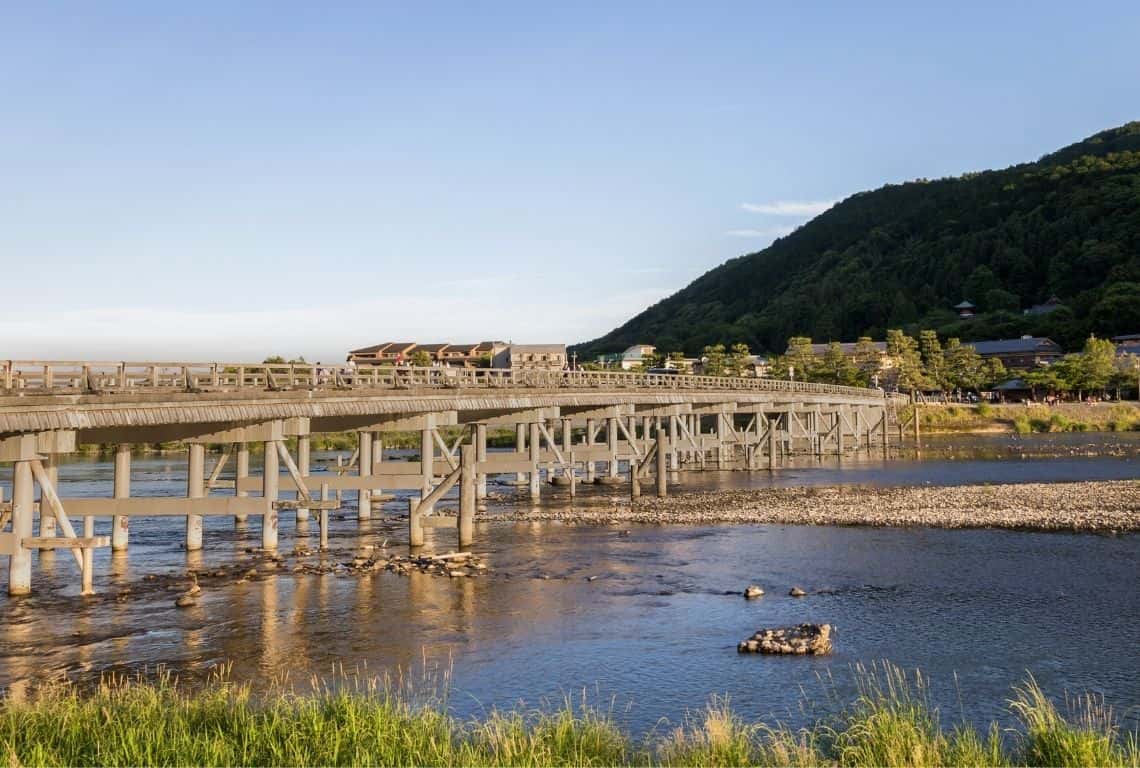
Take a Walk Across Togetsukyo Bridge / Things to Do in Arashiyama
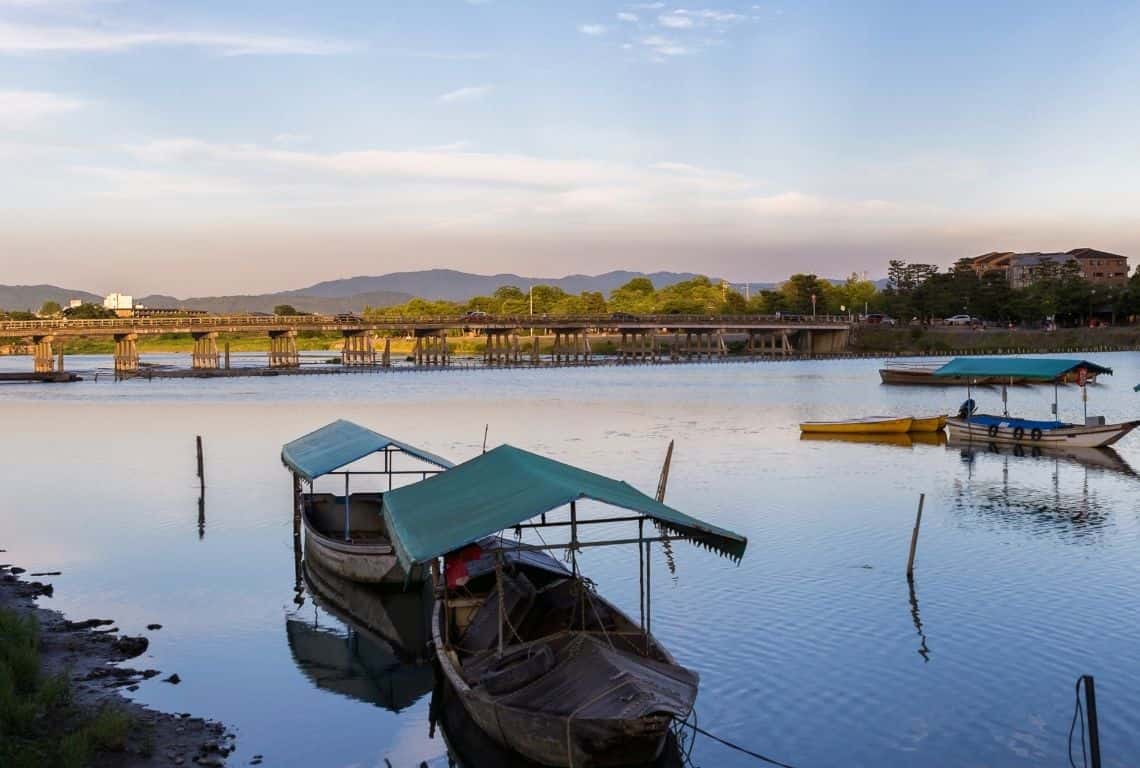
Visit Iwatayama Monkey Park in Arashiyama
When you cross the Togetsukyo Bridge turn right and you will see a sign for Iwatayama Monkey Park .
First of all, what you need to know, is that the hike up to the park is fairly strenuous. It is pretty much up a hill hike at a steady incline.
It will take you about 25-30 minutes to reach the top of the mountain where Iwatayama Monkey Park is located.
My recommendation is to just take your time and rest along the way. Specifically, if you are hiking during the summer months , make sure to have plenty of water with you and just take it easy.
If you want to feed the monkeys , you can purchase some food for them at the small shop located at the entrance to the park. Then, you will need to enter a shack with wires on the windows. The monkeys will be hanging on the wires and begging for food.
I do not particularly like this setup, because it trains the monkeys to beg for food.
When I visited the Jigokudani Snow Monkey Park located in the Nagano Prefecture on a day trip from Tokyo, it was an awesome better experience.
First of all, the monkeys are free to roam and come down from the mountains during feeding times or to soak in the hot springs.
Second, visitors are not allowed to feed the monkeys so they do not beg for food but instead go around their monkey business like playing, grooming each other, or enjoying the hot springs.
So, if you are looking forward to seeing monkeys in Japan, then hands down, go and see Jigokudani Snow Monkeys !
Intrepid’s Tip:
Read: 14 Practical Tips How to See SNOW MONKEYS in JAPAN (Best Trip from TOKYO)
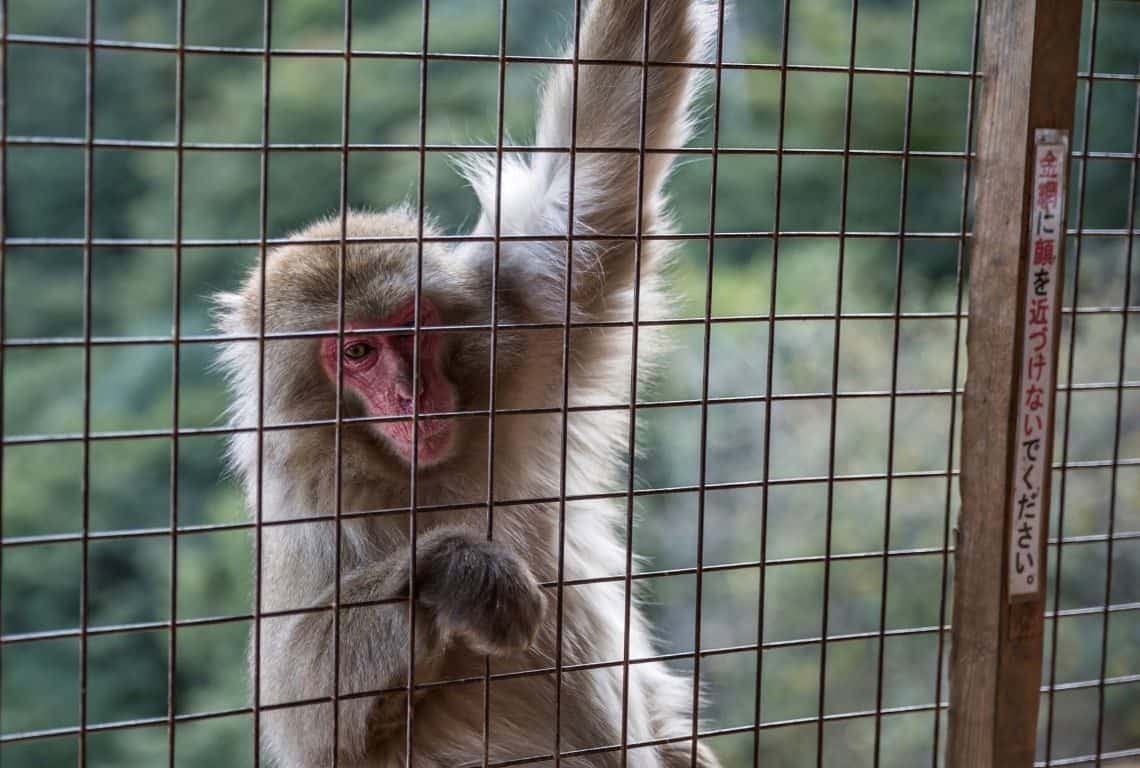
Visit Iwatayama Monkey Park in Arashiyama / Things to Do in Arashiyama
However, what I really like about Iwatayama Monkey Park in Arashiyama is that it sits on top of the Arashiyama Mountian and the views of Kyoto are absolutely breathtaking!
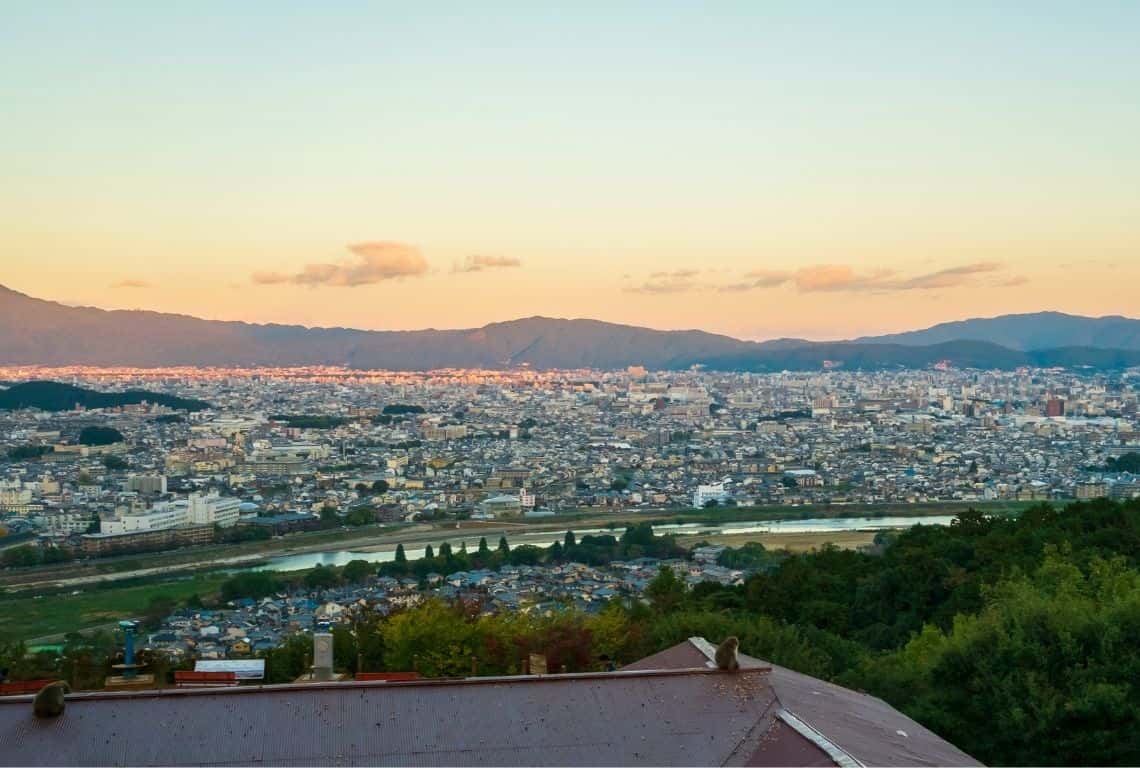
You can visit Arashiyama Monkey Park any day of the week from 9 am until 5 pm (March 15th through September 30th), or until 4 pm (October 1st through March 14th).
The entrance ticket to Arashiyama Monkey Park is 600 yen for adults and 300 yen for children ages 4 to 15. Children younger than 4 can monkey-watch for free.
Visit Tenryuji Temple in Arashiyama
Tenryuji Temple is no more than a 10-minute walk from JR Saga Arashiyama Station. Once you exit the station, go west and the temple complex will be right in front of you.
The temple was established in 1339 by the ruling shogun Ashikaga Takauji.
It is known that Takauji dedicated the temple to the memory of Emperor Go-Daigo.
Both, shogun Ashikaga Takauji and Emperor Go-Daigo used to be good allies until Takauji turned against the emperor in a struggle for supremacy over Japan.
After Emperor Go-Daigo passed away, Takauji built the temple to appease the former emperor’s spirits.
Tenryuji’s buildings were repeatedly lost in fires and wars over the centuries. Mostly, what we see today are buildings that date from the Meiji Period (1868-1912).
In 1994, Tenryuji Temple was registered as a UNESCO World Heritage Site, as part of the “ Historic Monuments of Ancient Kyoto “.
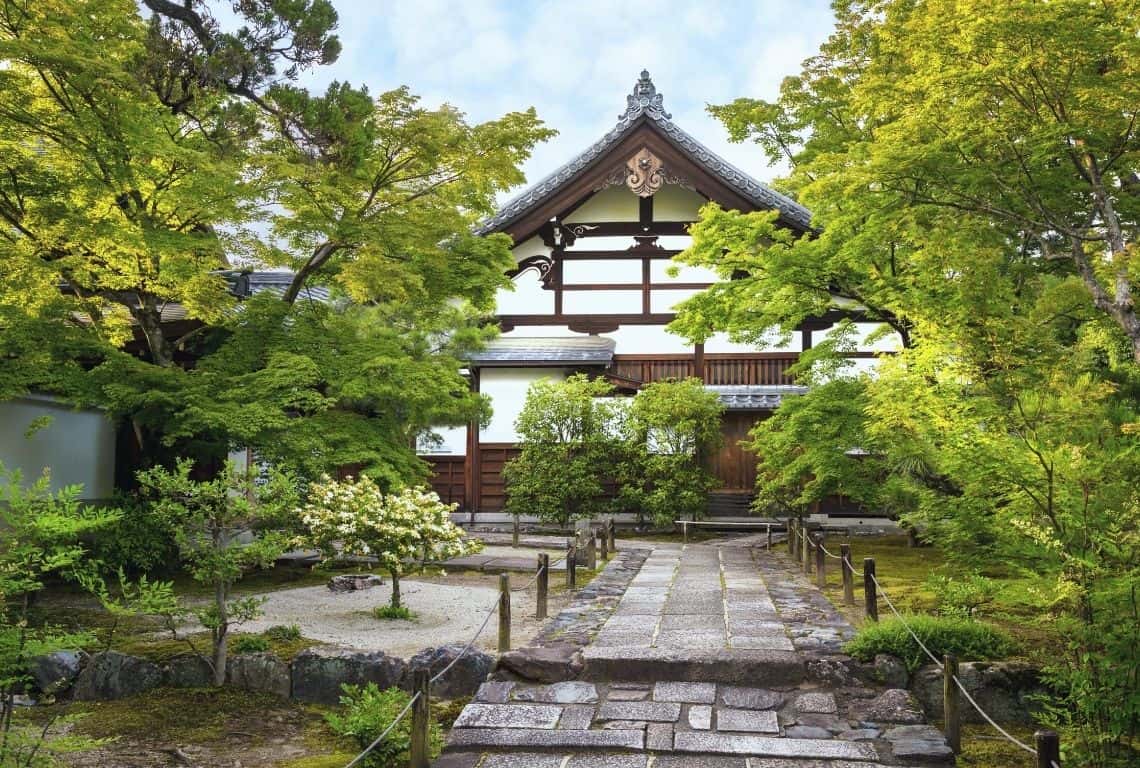
Visit Tenryuji Temple in Arashiyama / Things to Do in Arashiyma
There is a lot to see around the temple grounds. However, I think that you should visit:
- Hatto – Dharma Hall
- Kuri – Temple Living Quarters
- Hojo – Abbot’s Quarters
- Sogenchi Teien – Sogen Pond Garden
The Hatto – Dharma Hall was used for sermons. Nowadays, it is used for important ceremonial functions .
In 1899 the Hatto’s paneled ceiling was adorned with a large painting of a cloud dragon by the Meiji-period artist Suzuki Shonen.
In 1997 the old cloud dragon was replaced with a new cloud dragon painting by the nihonga artist Kayama Matazo It was created to commemorate the 650th anniversary of the death of Tenryuji’s founder, Muso Soseki.
Unfortunately, the visitors are not allowed to take pictures of the famous cloud dragon painting.
Needless to say, the painting of the cloud dragon by Matazo Kayama is amazing! I recommend that you see it!
It represents a massive blue-grey dragon that swirls out of the clouds and stares down at you no matter where you stand in the room. This effect, known in Japanese as happo-nirami – all-direction gaze , symbolizes the all-seeing eyes with which the dragon protects Buddhism.
Next, make sure to stop by Kuri – Temple Living Quarters .
Inside Kuri’s entrance hall is a large painting of Bodhidharma , a Buddhist monk who, according to Zen tradition, introduced Zen teachings to China 1,500 years ago.
The painting was done by the late Rev. Hirata Seiko, Chief Abbot of Tenryu-Ji.
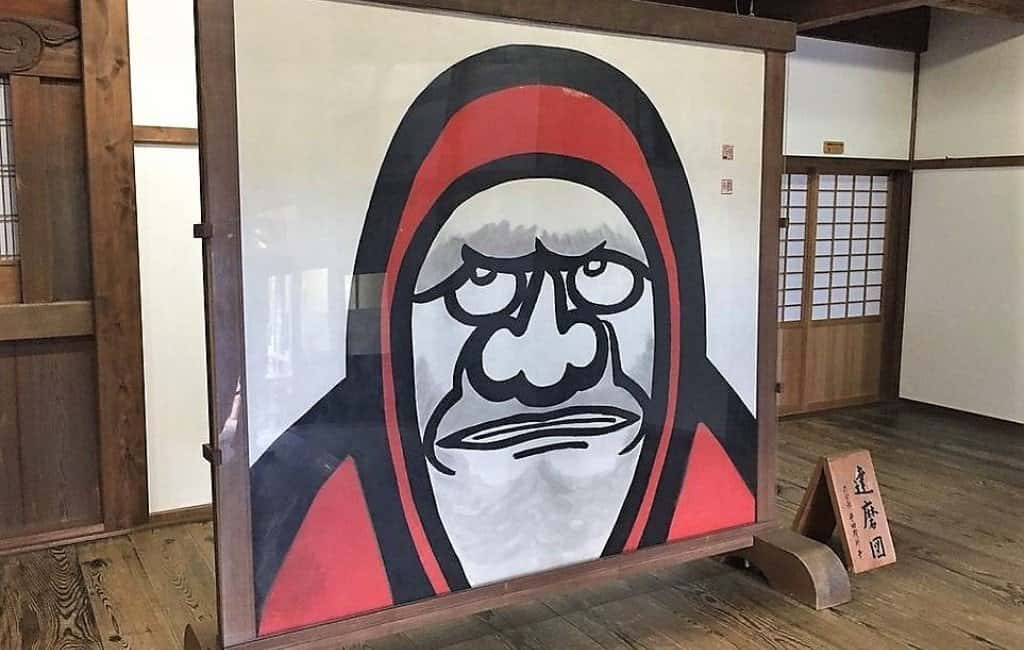
Visit Tenryuji Temple in Arashiyama / Things to Do in Arashiyama
Next, make your way to Hojo – Abbot’s Quarters .
The Hojo is made up of two sections, the Daihojo – Large Hojo and the separate Kohojo – Small Hojo, both of which are connected to the Kuri.
The Daihojo, Tenryu-ji’s largest building, has beautiful wide verandas. The ones on the back face the Sogen Pond. And, it is a perfect spot to take a short break here.
In addition, it is a great place to take a look at another large cloud dragon painted on the sliding doors by the artist Wakasa Butsugai.
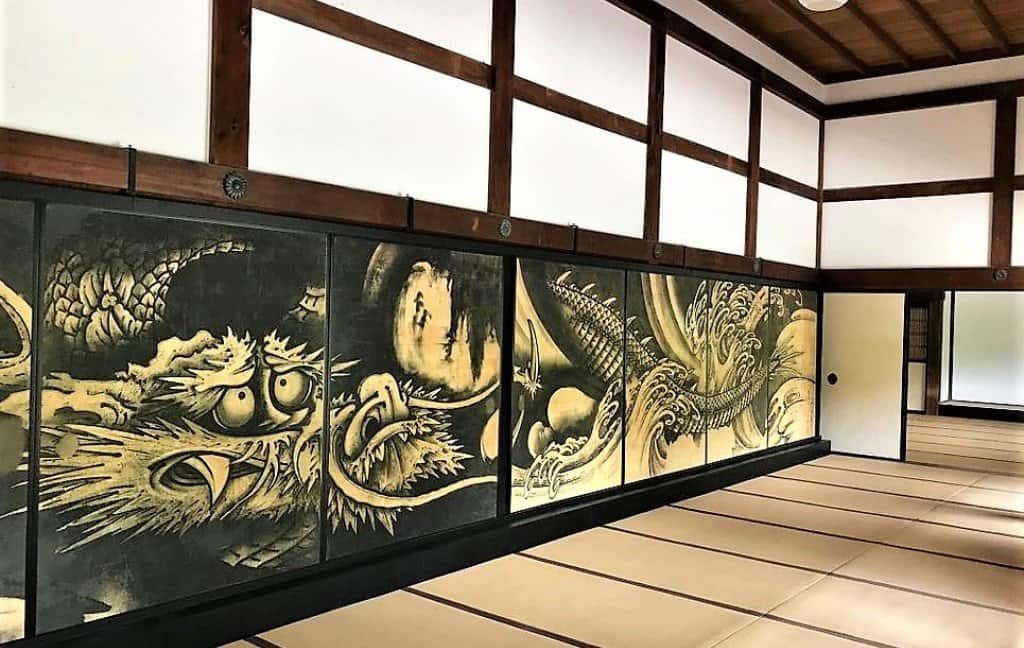
Finally, make sure to stop by Sogen Pond Garden .
Unlike the Tenryuji’s temple buildings, Sogen Pond Garden created by the famous garden designer Muso Soseki nearly 700 years ago, survived the centuries in its original form.
Notably, it was designated by the Japanese Government as a Site of Specific Historic and Scenic Importance.
Sogenchi Teien – Sogen Pond Garden was designed as a ‘strolling pond garden’. It means that the the path surrounding the pond takes the visitors around the pond and allows them to appreciate the scenery from a variety of perspectives.
In addition, it employs a ‘borrowed scenery technique’ – shakkei, which means that the surrounding scenery is incorporated into the garden.
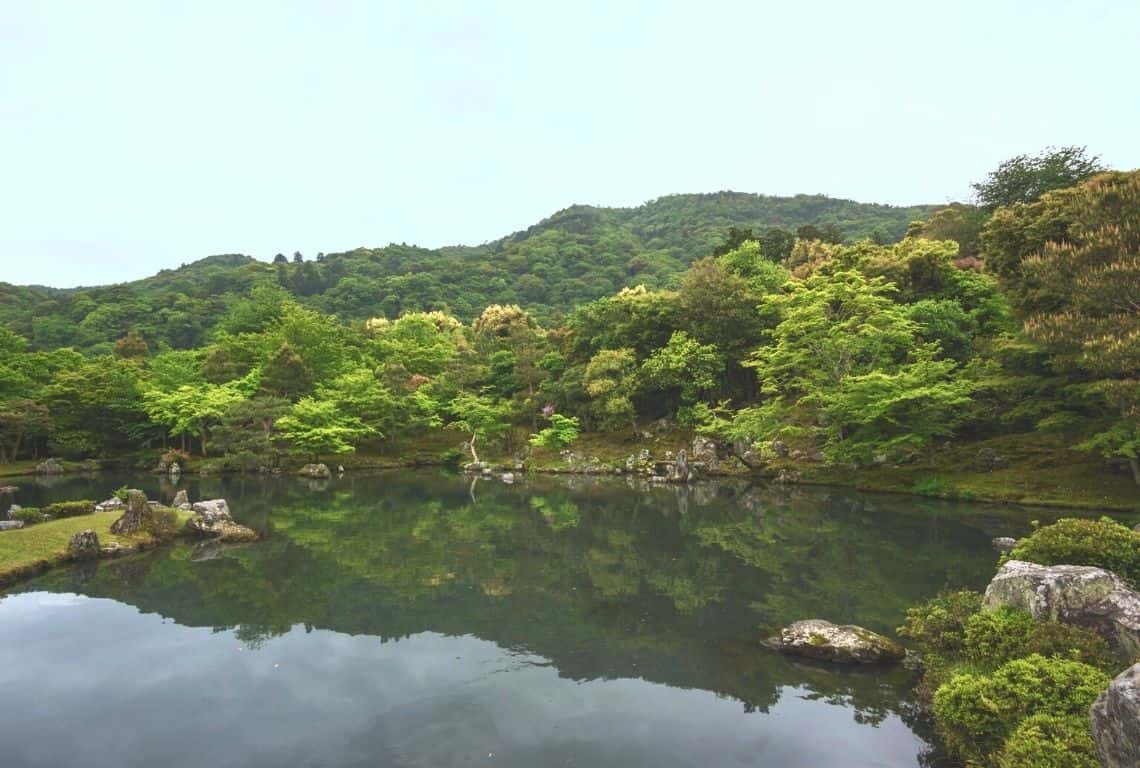
Tenryuji Temple is open from 8:30 am to 5:30 pm and the last admission is at 5 pm. However, from October 21 through March 20, the opening hours are 8:30 am to 5 pm and the last admission is at 4:30 pm.
The entrance ticket to the garden is 500 yen. If you wish to tour the garden and the Tenryuji buildings, then there is an additional charge of 300 yen. And, finally, if you want to see the painting of the Cloud Dragon, then there is a separate entrance ticket with costs an additional 500 yen.
The Dharma Hal, where the painting is located, is open on Saturdays, Sundays, and holidays only. And, the opening hours are from 9 am till 5 pm. However, during winter months (October through March), the opening hours are 9 am to 4 pm.
Stop by Nonomiya-jinja Shrine
Nonomiya-jinja Shrine is a small shrine but it has a fascinating history and it is worth the stop . Of all the things to do in Arashiyama, this place had a special charm for me.
The shrine was formerly known as a purification shrine for imperial princesses appointed as priestesses for Ise Grand Shrine .
Emperors often sent their unmarried daughters to serve as high priestesses at the Grand Shrine of Ise. However, before they could acquire a status of a high priestess, they had to spend one to three years of their lives undergoing a purification process at Nonomiya-jinja Shrine.
Despite being a small shrine, Nonomiya-Jinja is very popular. It is believed that a visit to this temple can help single women and men with the matchmaking processes . In addition, mothers-to-be pray here for safe delivery.
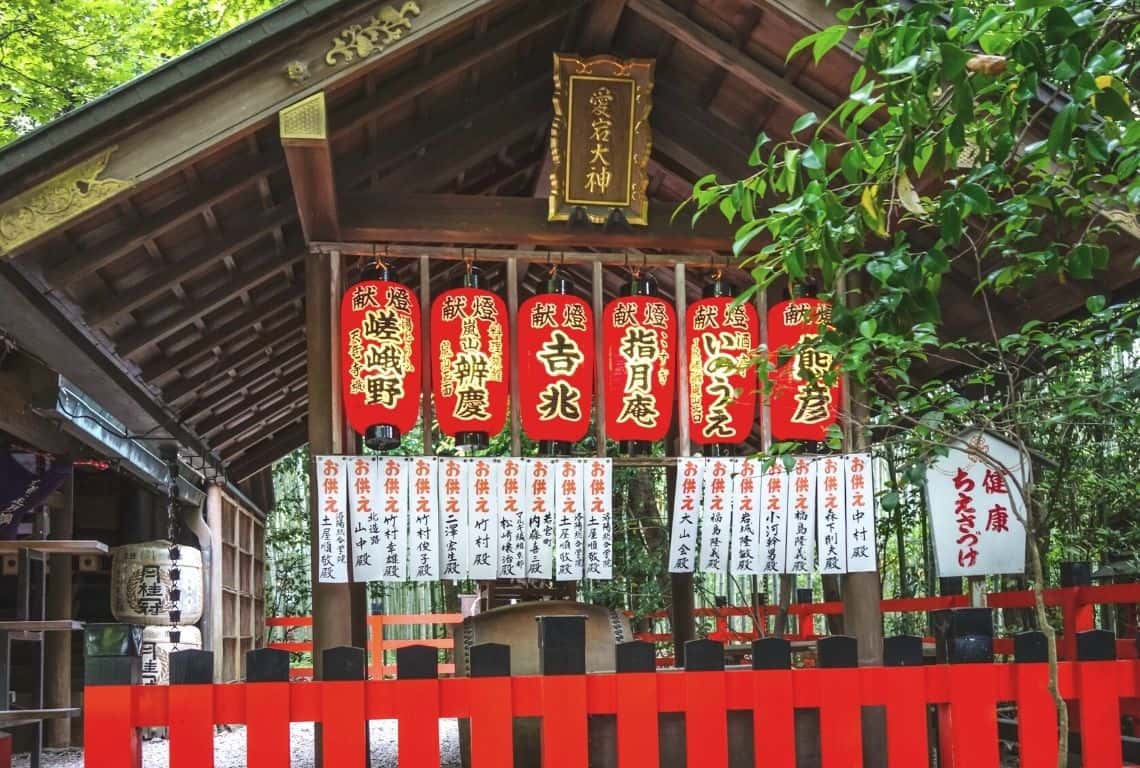
Stop by Nonomiya-jinja Shrine / Things to Do in Arashiyama
Nonomiya-jinja shrine is located right next to Tenryuji Temple .
So, right after you are done visiting Tenryuji Temple, exit the temple grounds and continue west for no more than 5 minutes before you reach Nonomiya-jinja Shrine.
Take a Tour of Okochi Sanso Villa and Garden
Of all the things to do in Arashiyama, visiting Okochi Sanso Villa and strolling through the garden is one of my favorite things to do .
Okochi Sanso Villa is a stunning residence of the former Japanese actor Okochi Denjiro .
Okochi Denjiro was born on February 5, 1898 in Iwaya-mura, Chikujo-gun, Fukuoka Prefecture, Japan as Masuo Oobe. He was an actor and writer, known for No Regrets for Our Youth (1946), Sanshiro Sugata (1943), and The Men Who Tread on the Tiger’s Tail (1945). He died on July 19, 1962.
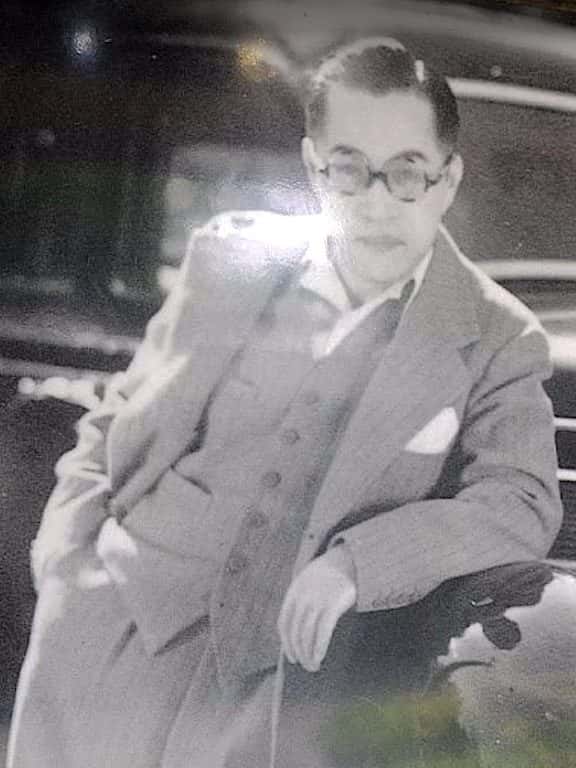
Take a Tour of Okochi Sanso Villa and Garden / Things to Do in Arashiyama
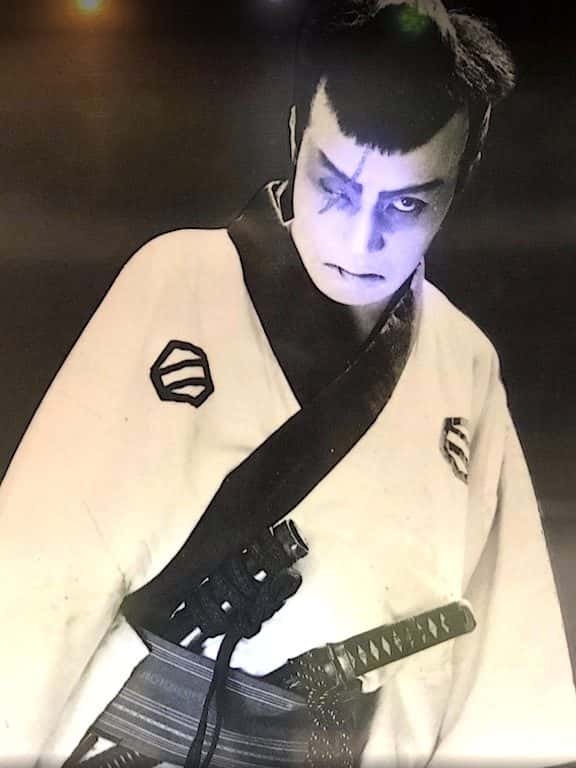
Take your time and explore the villa and the surrounding areas around the villa.
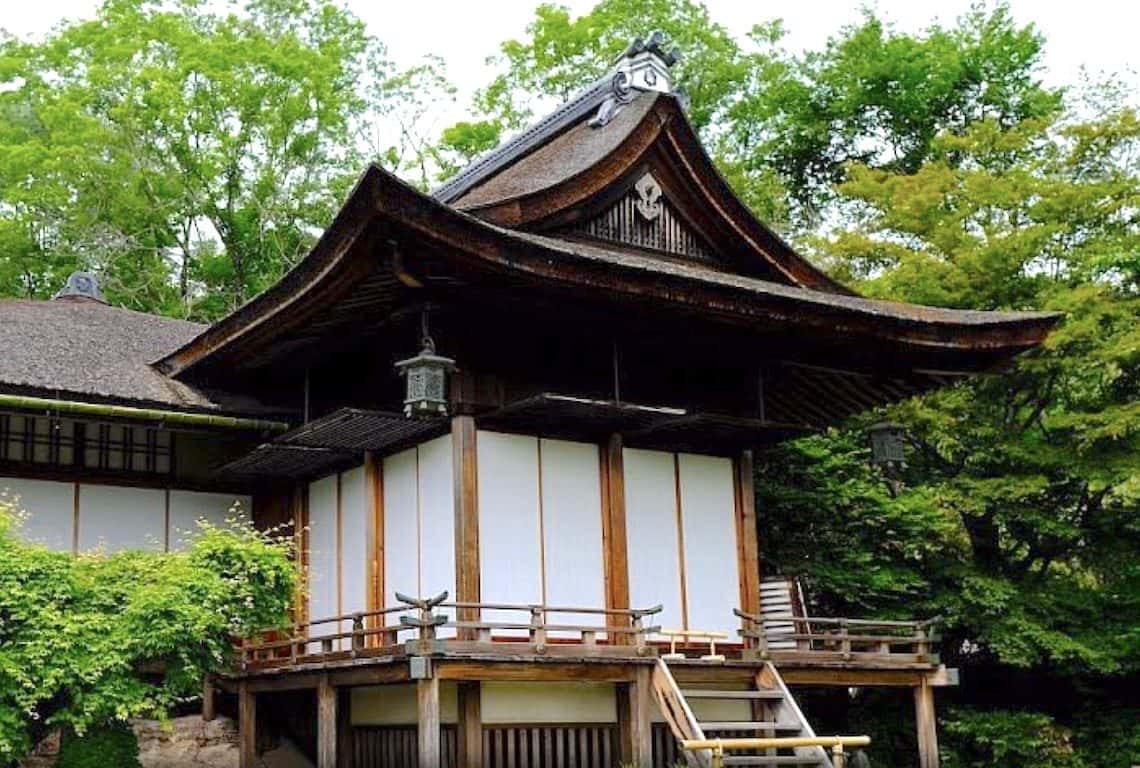
However, what really should deserve your full attention is an exquisite garden. The garden is simply manicured to perfection! It has lots of intriguing pathways and several stunning views of the mountains.
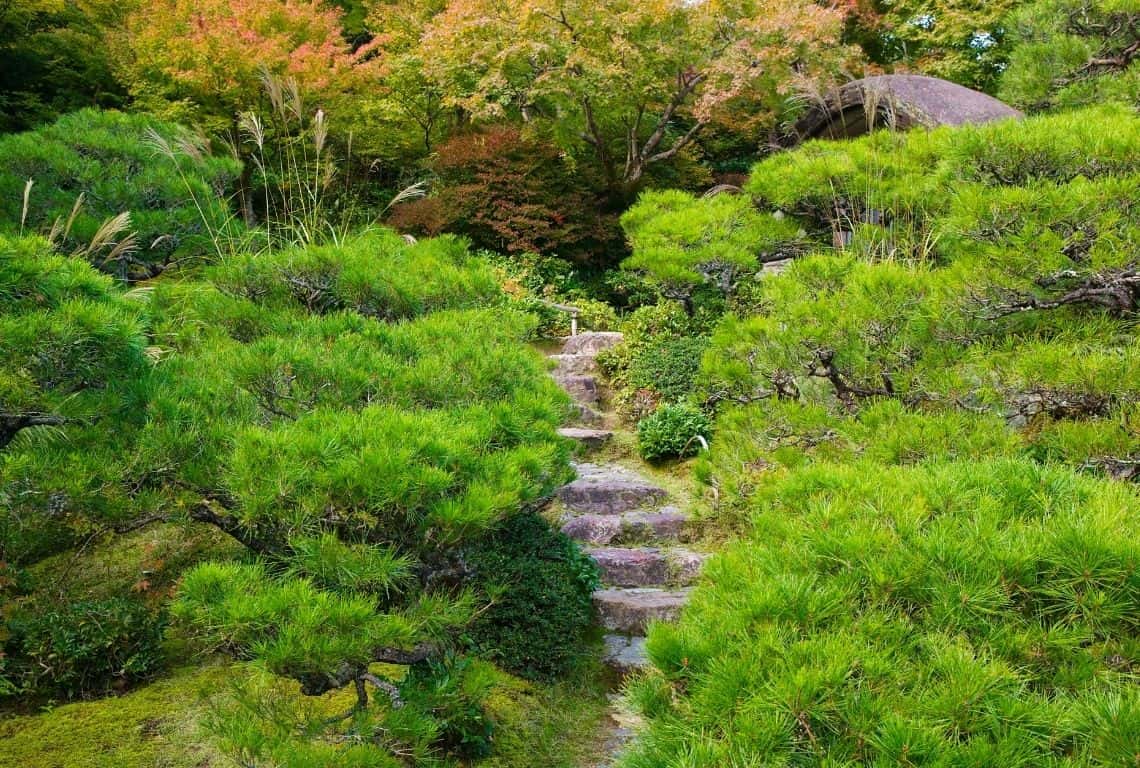
Okochi Sanso Villa is located west of Nonomiya-jinja shrine and west Tenryuji Temple. It will take you no more than 10 minutes to reach Okochi Sanso Villa and Garden if you are walking from Tenryuji Temple to Nonomiya-jinja Shrine.
You can tour Denjiro’s mossy, manicured gardens daily from 9 am until 5 pm. The admission is 1,000 yen and includes matcha green tea and cake.
Explore Jojakkoji Temple in Arashiyama
Once you visit Jojakkoji Temple, you will agree that it is one of the best things to do in Arashiyama !
Jojakko-ji Temple is nestled on the slope of Mount Ogura. This Nichiren sect temple was opened in the late Momoyama period (14th century) by a monk who had used it as his retirement residence.
First of all, you enter the grounds of Jojakkoji Temple through Sanmon Gate , which is the main gate. It is built with rectangular timbers arranged in the beautiful latticework. The gate was renovated in the late Edo period (1603-1868).
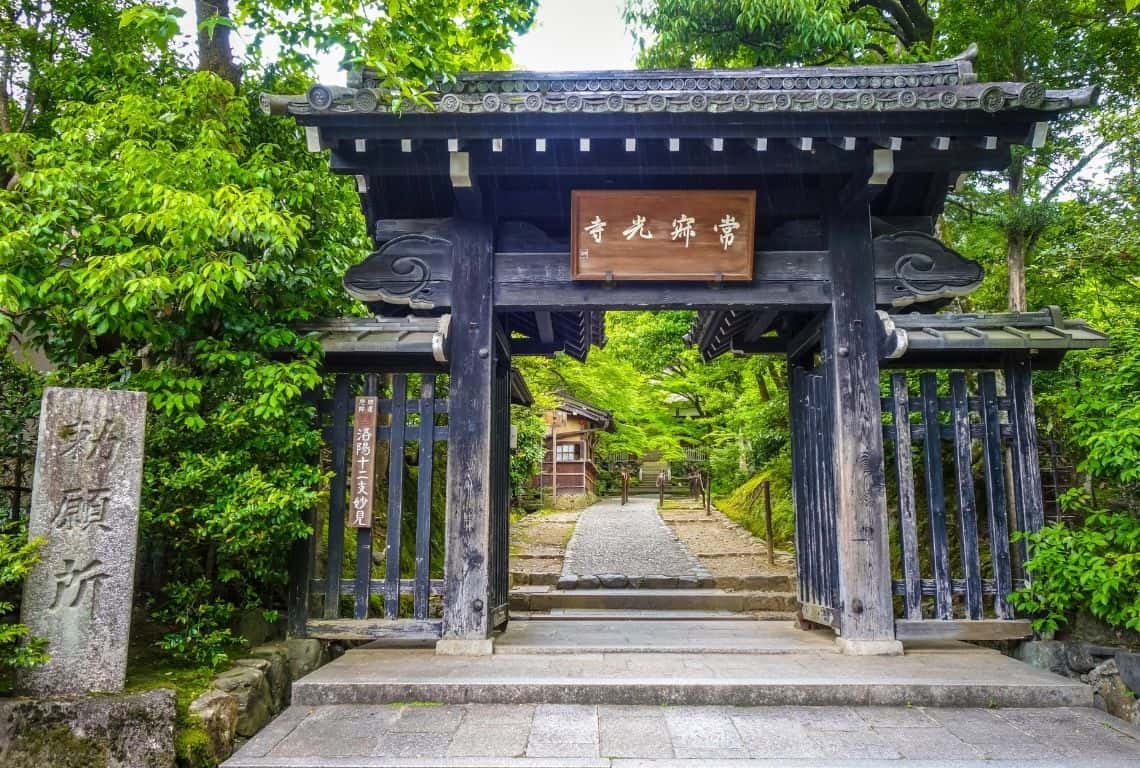
Explore Jojakkoji Temple in Arashiyama / Things to Do in Arashiyama
Next, you continue on to the next gate – Niomon Gate , which served originally as the south entrance to the Guest Hall.
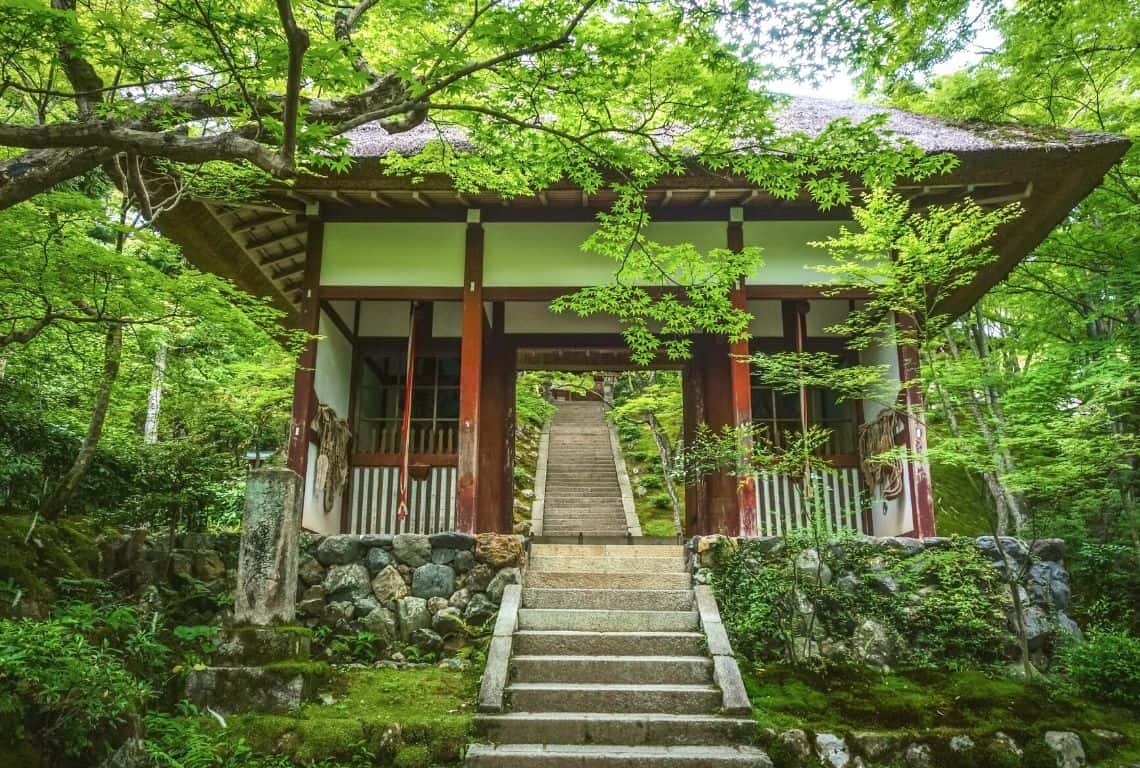
Finally, you will reach the Main Hall. This Main Hall was originally a Guest House of Momoyama Castle and it was moved to Jojakko-Ji Temple.
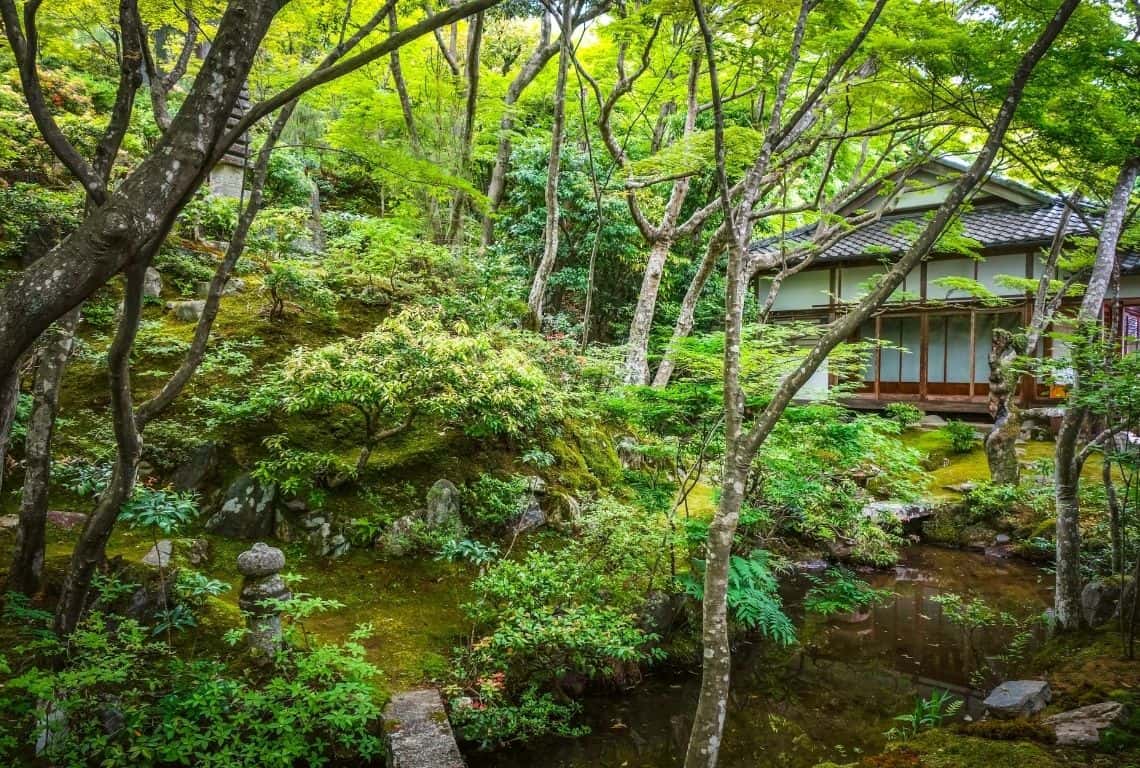
I want to encourage you to continue hiking up the mountain. On your way, you will reach Tahoto Pagoda (Two-storied Pagoda).
At this point, you are almost at the top of the mountain. You will be rewarded with the most magnificent views of the Sagano area .
On the way down make sure to stop by the Monks’ Quarters .
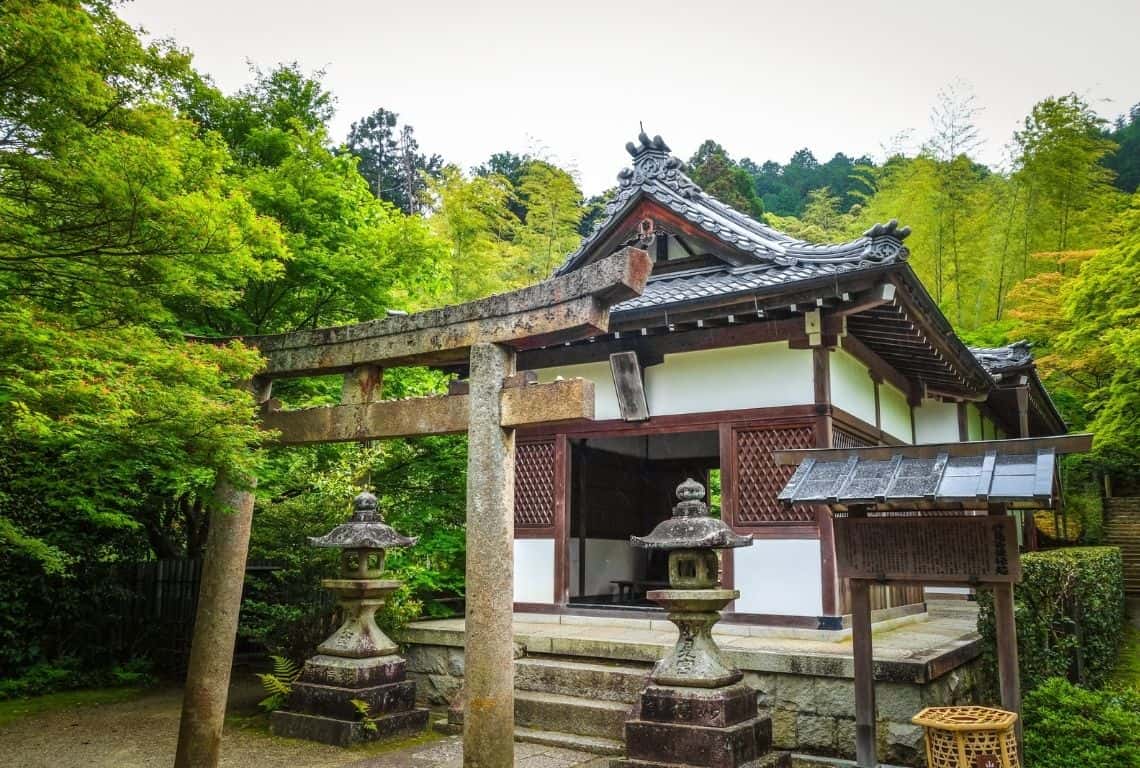
Jojakkoji Temple is located no more than a 10-15 minute walk from the Bamboo Grove going north.
However, if you are heading from Okocho Sansa Villa and Garden then Jojakkoji Temple will be your next stop going north.
Jojakkoji Temple is open daily from 9 am to 5 pm. The admission fee is 300 yen.
Head to Adashino Nenbutsuji Temple
Adashino Nenbutsuji Temple was founded in the 9th century by the monk Kodo Daishi who placed stone statues for the souls of the dead . Today the temple is home to thousands of stone statues.
There is a somber, reverent atmosphere here. You can only take pictures from the distance.
If you have a camera with a good lens, then you will be able to take some great pictures of the stone statues.
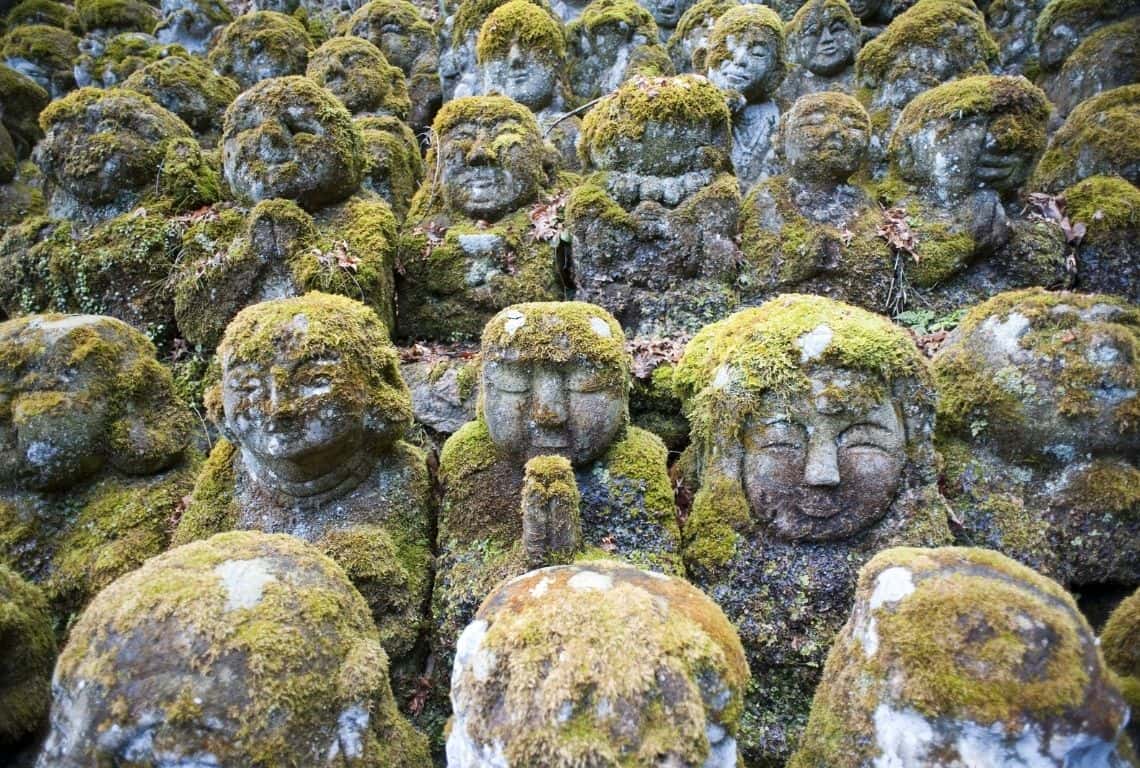
Head to Adashino Nenbutsuji Temple / Things to Do in Arashiyama
The added bonus is t he most beautiful, quiet bamboo grove.
Here, you will finally be able to stroll around all by yourself. Strangely enough, the crowds of tourists are completely unaware of this beautiful place.
I honestly feel that the bamboo forest surrounding Adashino Nenbutsuji Temple is Arashiyama’s hidden gem !
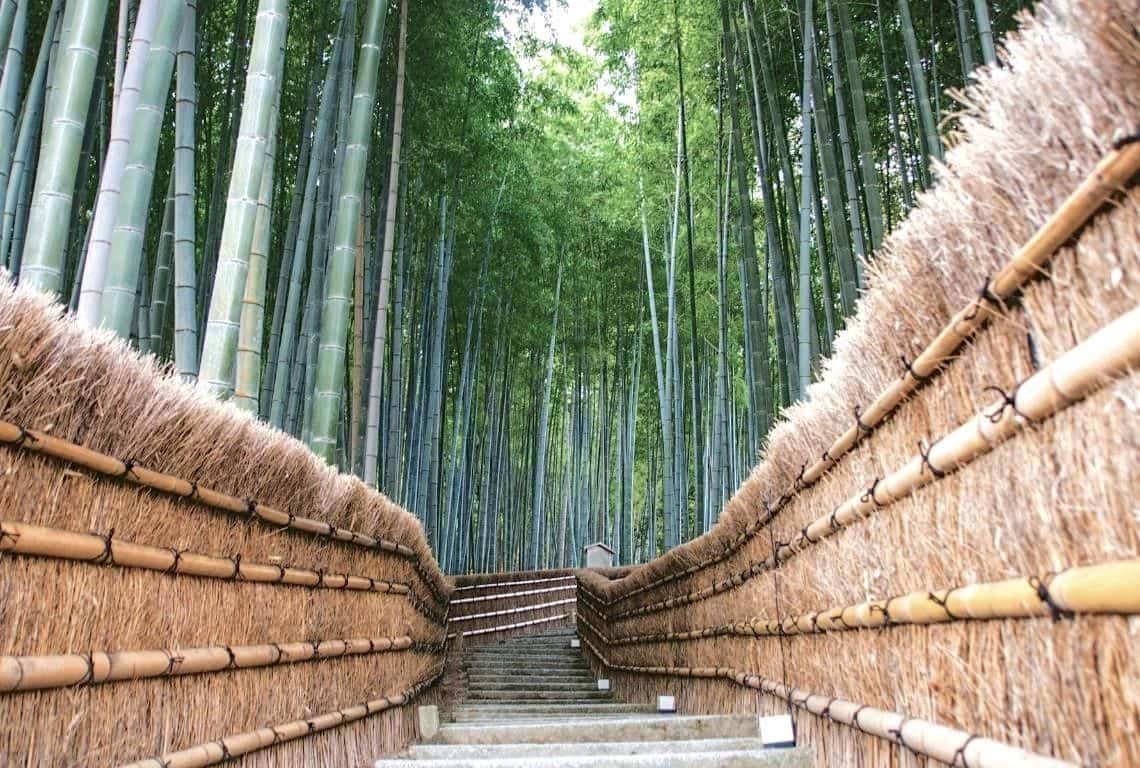
It is super easy to get to Adashino Nenbutsuji Temple.
First of all, from the last location, continue north.
You will pass the Sagano Doll House Museum and shortly, you will reach Saga Toriimoto Preserved Street .
Once you reach Saga Toriimoto Preserved Street, turn left and walk for no more than 5-10 minutes.
The Temple grounds will be on your left.
The opening hours are from 9 am to 4:30 pm March through November and 9 am to 3:30 pm December through February.
The entrance ticket is 500 yen.
Take a Stroll Along Saga Toriimoto Preserved Street
When you exit Adashino Nenbutsuji Temple continue east.
You will be strolling along Saga Toriimoto Preserved Street in about 10 minutes after you exit the temple.
Saga Toriimoto Street has been preserved in the style of the Meiji Period (1868-1912).
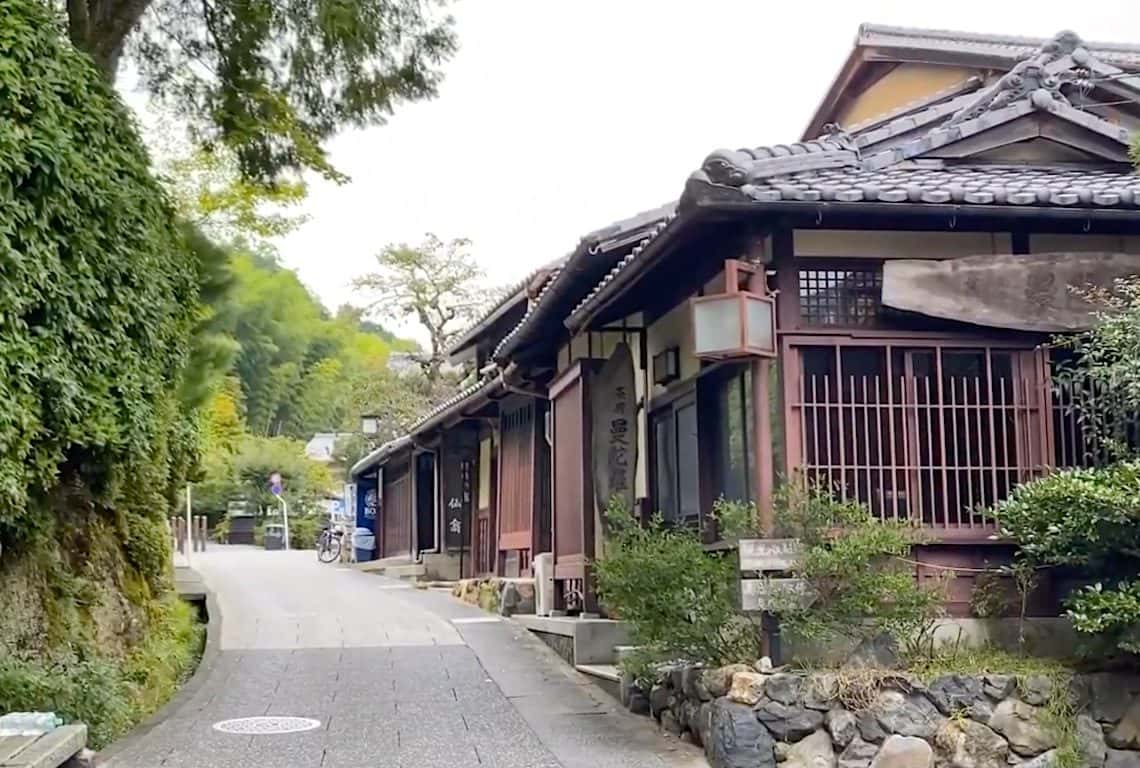
Take a Stroll Along Saga Toriimoto Preserved Street / Things to Do in Arashiyama
Many of the buildings are traditional machiya (townhouses) that served as private residences but have since been converted into shops and restaurants.
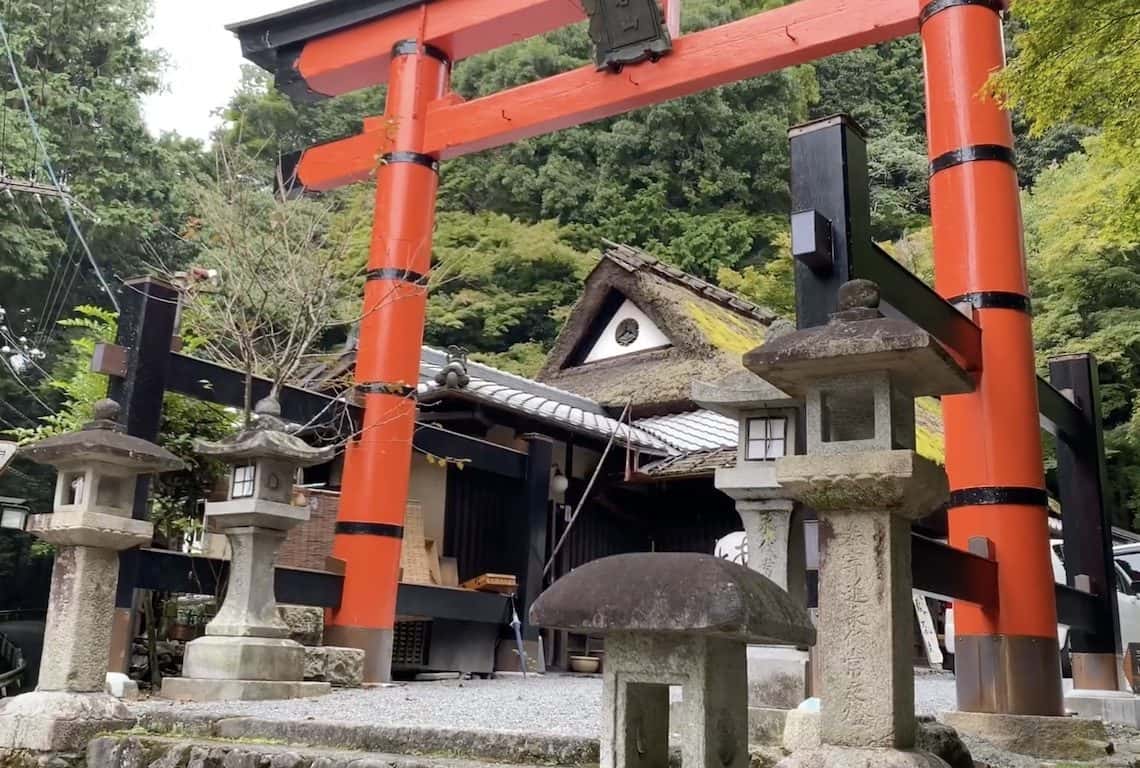
Take a Ride on Sagano Romantic Train
Sagano Romantic Train travels from Saga Torokko Station to Kameoka Torokko Station .
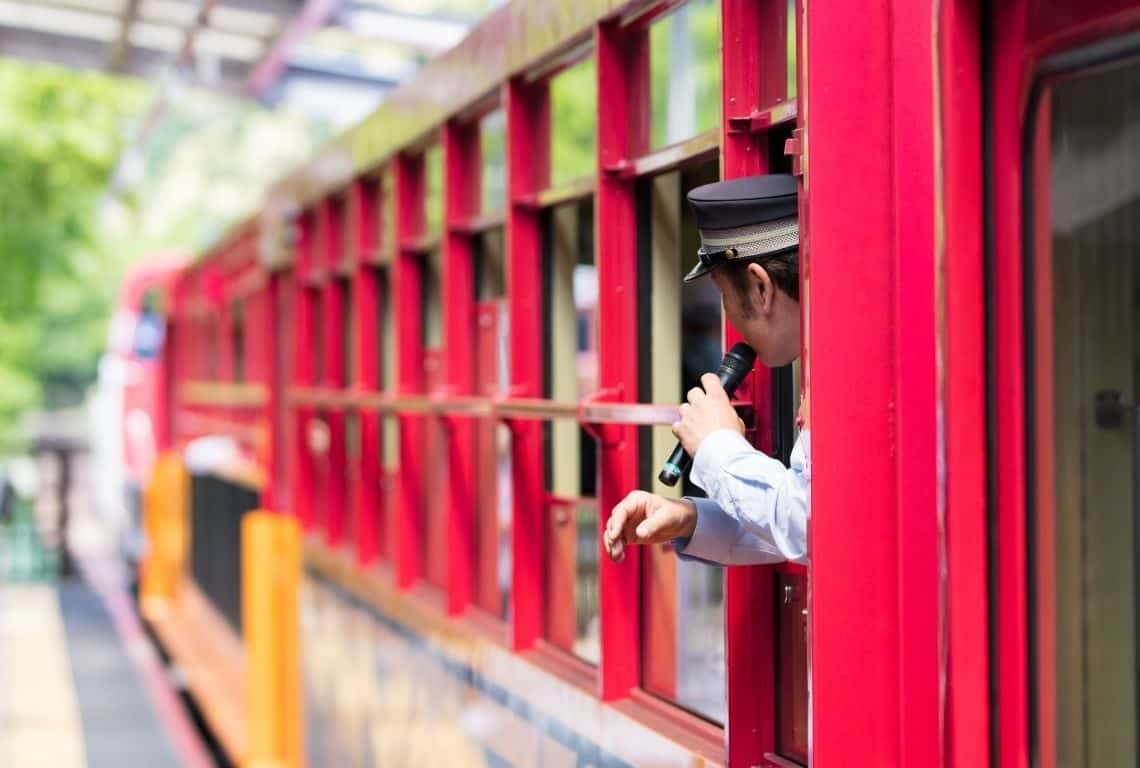
Take a Ride on Sagano Romantic Train / Things to Do in Arashiyama
It is a beautiful 7 km (25 minutes) ride along Hozukyo Ravine .
The ride is fun no matter what time of the year you are visiting! Moreover, the train goes at a leisurely pace, which will allow you to take plenty of pictures.
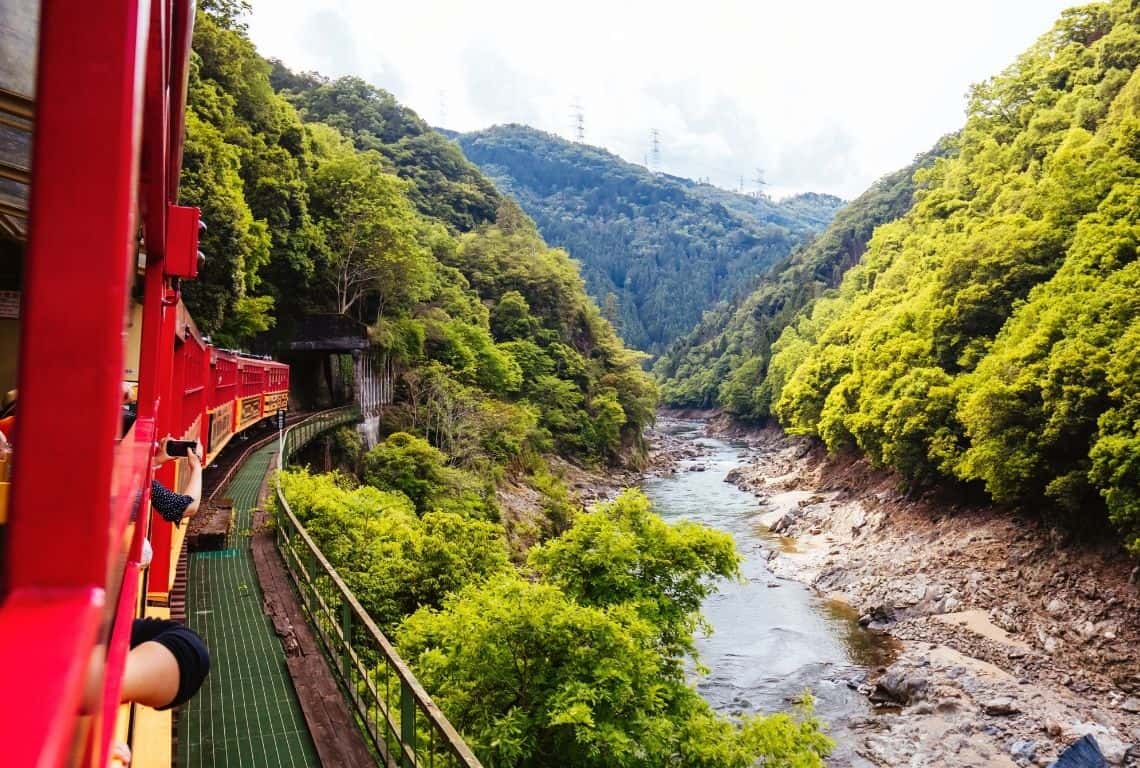
You can board the train at Saga Torokko Station , which is next to JR Saga Arashiyama Station .
After the train ride, when you reach Kameoka Trokko Station , you can hop back on the return train and get back to Arashiyama, or you can walk to JR Umahori Station and catch a train back to Kyoto.
What you need to know is that the trains leave every hour between 9 am and 5 pm. However, Sagano Romantic Train does not operate on Wednesdays. In addition, it stops operating from the end of December through the end of February.
It is a good idea to purchase the train tickets in advance since the train is very popular!
You can reserve the tickets through JR West online reservation service starting one month prior to the train ride.
Where to sit on Sagano Romantic Train? The best car is The Rich Car. It is an open-air car.
However, the advance tickets for The Rich Car are not available. There are only same-day sales!
My recommendation is to go to Saga Torokko Station as soon as you arrive in Arashiyama and purchase the tickets. Or, you can exchange the tickets you bought in advance for “The Rich” Car tickets (if available).
Join Arashiyama Cormorant Fishing Tour
If you are visiting between July 1st and September 23rd , you should look into a cormorant fishing (ukai) tour.
It is a traditional fishing method that uses trained cormorants called ‘Umiu’ to catch fish.
The fishermen use large flaming torches to attract fish. They make cormorants dive under the water and catch the fish by swallowing them. The fish is kept in the cormorant’s throat and later on retrieved by the fishermen.
This traditional fishing method has almost disappeared, and these days, ukai is held mainly as an attraction for tourists.

Join Arashiyama Cormorant Fishing Tour / Things to Do in Arashiyama
The first cormorant fishing tour leaves at 7 pm, followed by the second tour scheduled at 8 pm.
The cormorant fishing tours are expensive but totally worth the cost. Expect to pay 1,800 yen for a single adult ticket.
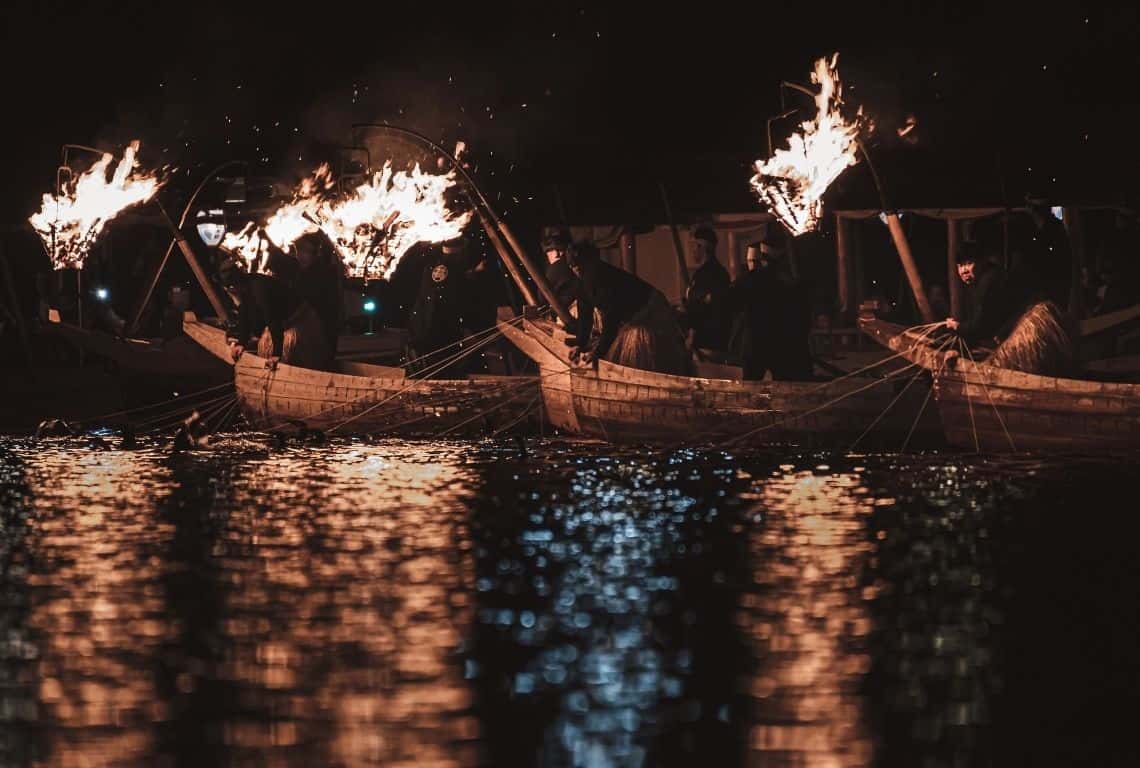
The cormorant fishing tours are located right next to Togetsukyo Bridge. If you are arriving at JR Saga Arashiyama Station , then head south towards Togetsukyo Bridge .
Continue south and you will reach Togetsukyo Bridge in about 10-15 minutes. The boats are located right next to Togetsukyo Bridge .
Attend Arashiyama Hanatouro Illumination Festival
If you are visiting Arashiyama in December , then it is perfect timing to attend Arashiyama Hanatouro Illumination .
Notably, Kyoto’s Hanatouro Festival is held twice a year. During the month of March, it is held in the Higashiyama area, and in December, it is scheduled in Arashiyama. By the way, Hanatouro means “ path with flower and light”.
During Hanatouro illumination Festival in Arashiyama , the iconic Togetsukyo Bridge, the Bamboo Grove, and the foothills of the surrounding mountains are all lit up. It is a visually stunning sight !
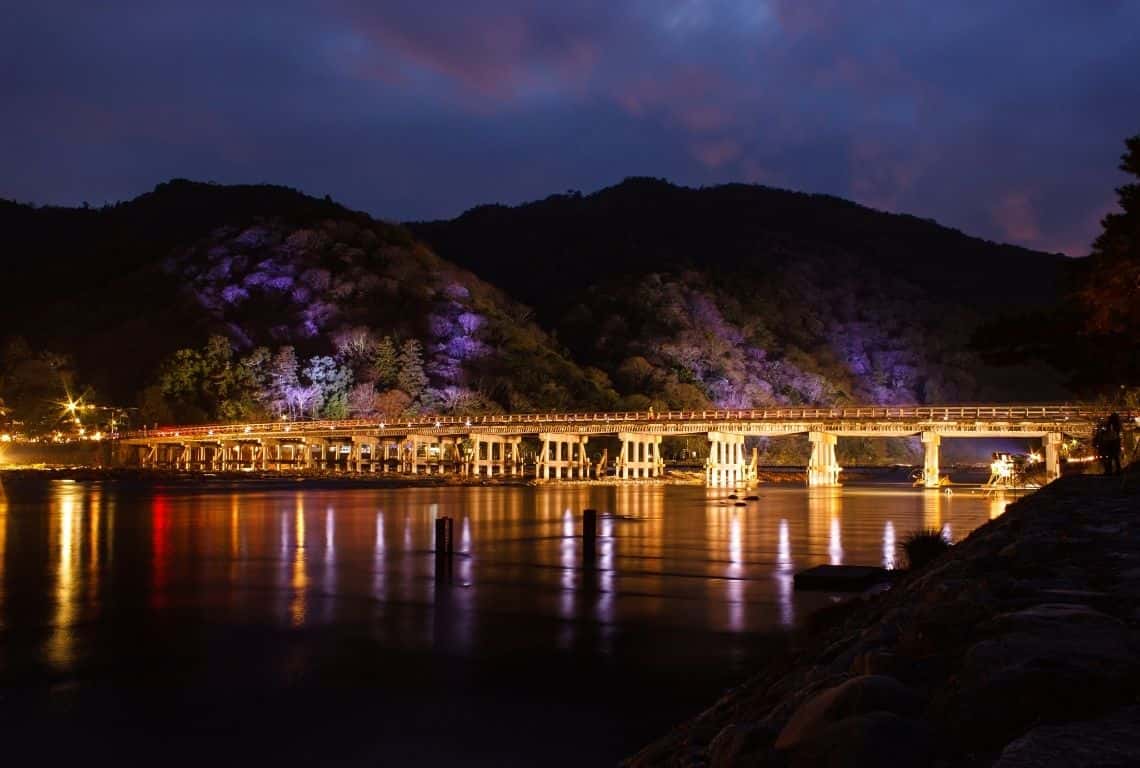
Attend Arashiyama Hanatouro Illumination Festival / Things to Do in Arashiyama
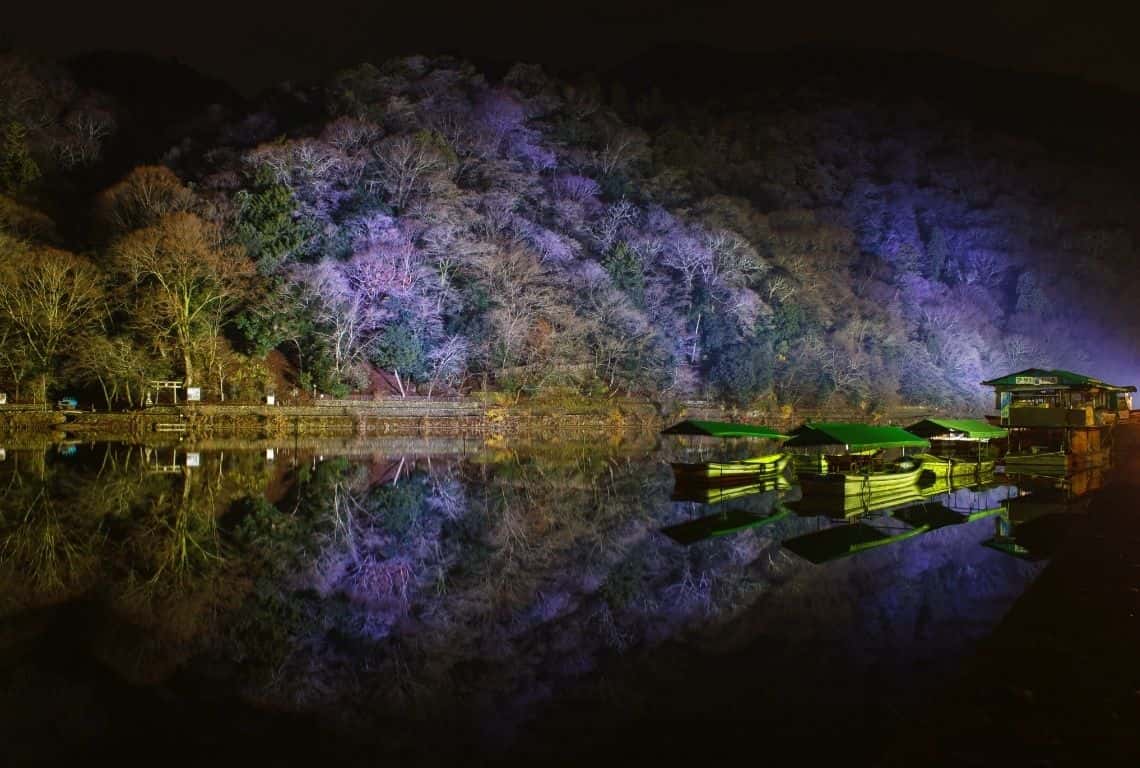
Go on Hozugawa River Boat Ride
Hozugawa River Boat Ride is an awesome boat ride on the Hozugawa River that takes you on a 2-hour journey (16 kilometers) from Tanba-Kameoka all the way to Arashiyama in Kyoto.
The scenery along the way is absolutely breathtaking!
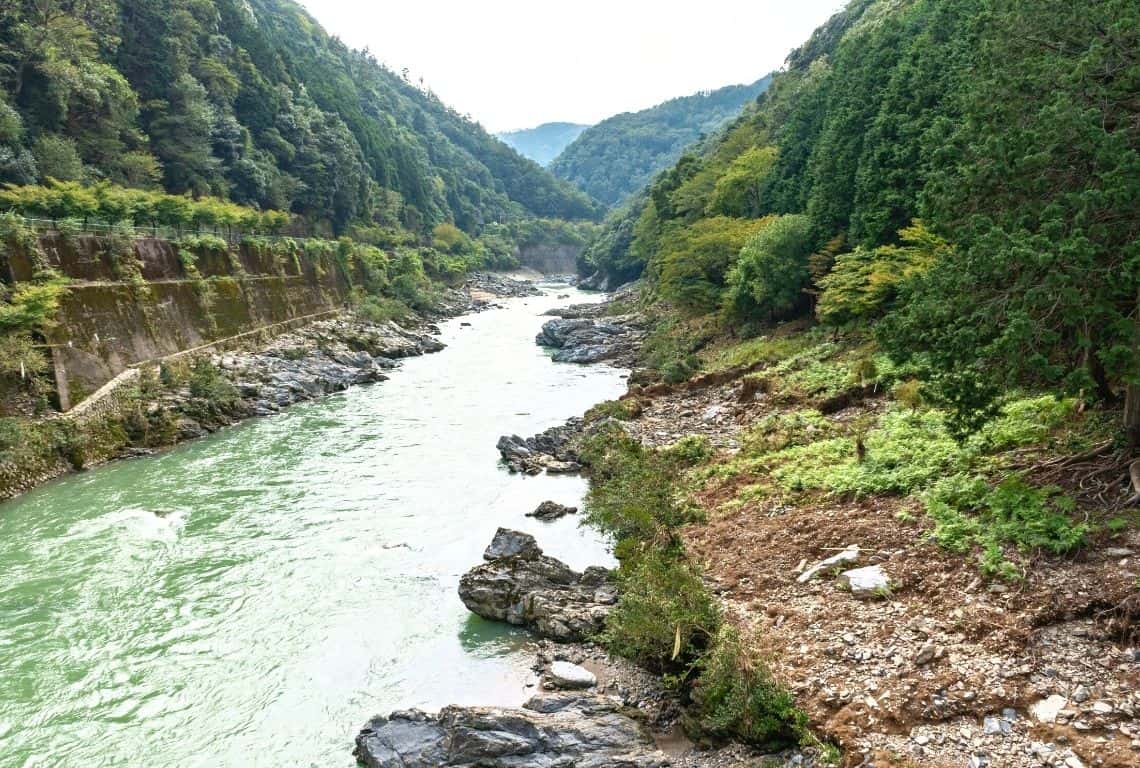
Go on Hozugawa River Boat Ride / Things to Do in Arashiyama
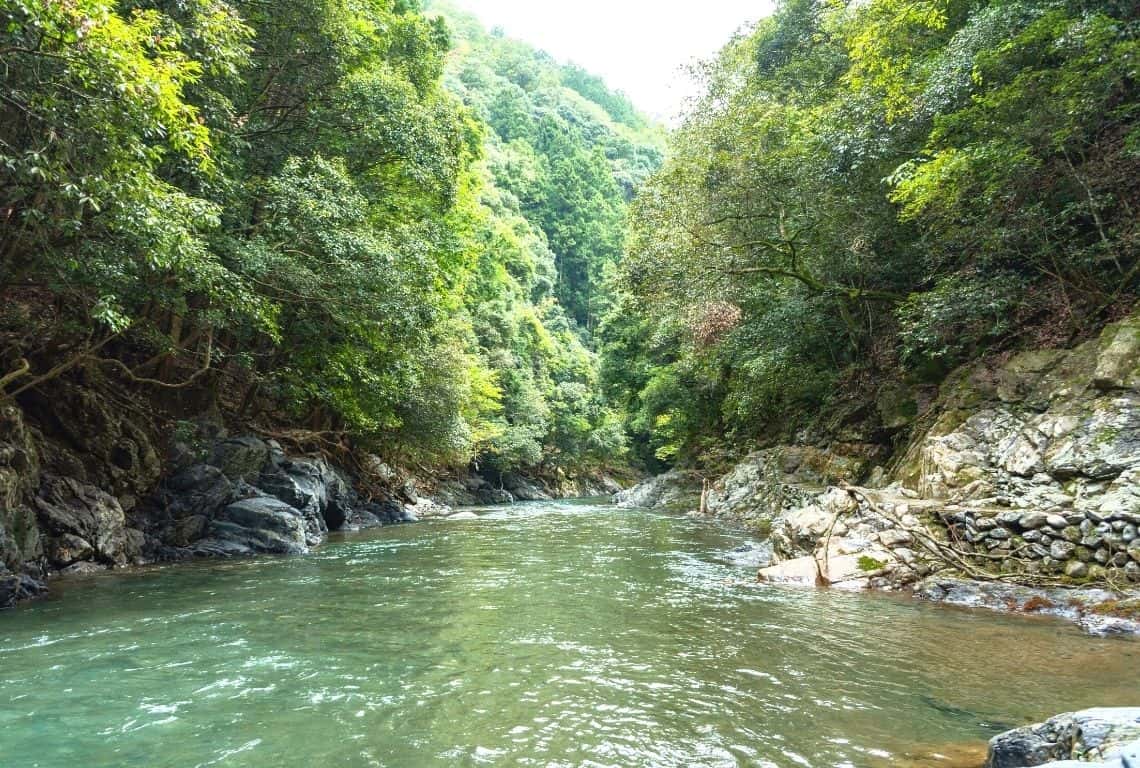
One of the highlights of this boat ride is seeing how the 3-person crew navigates the boat through some rapids using long bamboo sticks.
Each crew member has a distinct role!
The boat person at the bow is the sao-sashi , and their job is to use the long pole and push the boat forward and adjust the direction. The kai-hiki uses the oar and acts as the engine. At the stern of the boat is the kaji-tori who operates the rudder to navigate the ship.
The most important thing is for the three-person crew to work as one.
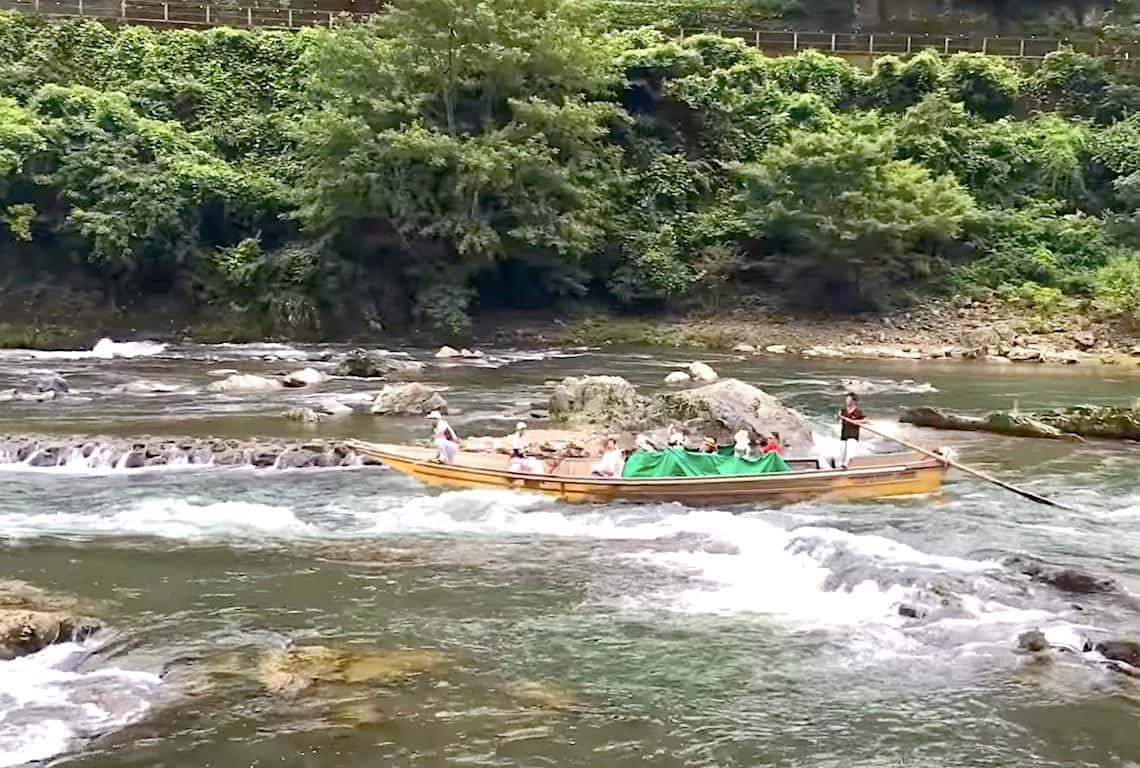
What you need to know is that you should combine the Hozugawa River Boat Ride with the Sagano Romantic Train Trip , as they both run in the same area. You can take the Sagano Romantic Train one way and the Hozugawa River Boat Trip back, or vice versa.
From Kyoto Station , take a 20-minute train ride to JR Kameoka Station . Then, you can either take a short bus ride (ticket cost is 160 yen) or a 10-minute walk to the Hozugawa River Boat Ride boarding site .
Hozugawa River Boat Rides start from 9:00 AM and cost 4,100 yen for adults and 2,700 yen for children four years of age to elementary school students.
Intrepid Scout's Tips for Things to Do in Arashiyama
Now, this is quite a list of things to do in Arashiyama! What if you only have one day in Arashiyama? What do you do? Here are the top things to do in Arashiyama that you should add to your Arashiyama itinerary.
- Hands down, one of the top things to do in Arashiyama is to take a walk through Arashiyama Bamboo Gove . It is absolutely stunning! Make sure to get there as early in the morning as possible to avoid the crowds and capture some awesome pictures.
- Next, visit Tenryuji Temple and stroll through the wonderful temple grounds. And, check out the stunning garden.
- Lastly, head to Jojakkoji Temple . The temple grounds are beautiful and if you are up to it, then hike all the way to the top of the hill for the most spectacular views of Kyoto .
Now, if you prefer to join a guided tour, then my recommendation is to check out: Kyoto Arashiyama & Sagano Walking Food Tour . You will stroll over the Togetsukyo bridge and then make a few stops to sample local delicacies. After a visit to the 14th-century Tenryu-ji temple, you will head over to the beautiful bamboo forest and afterwords try some traditional Japanese sweets.
Did You Find Things to Do in Arashiyama Useful?
Why not save it to your pinterest board.
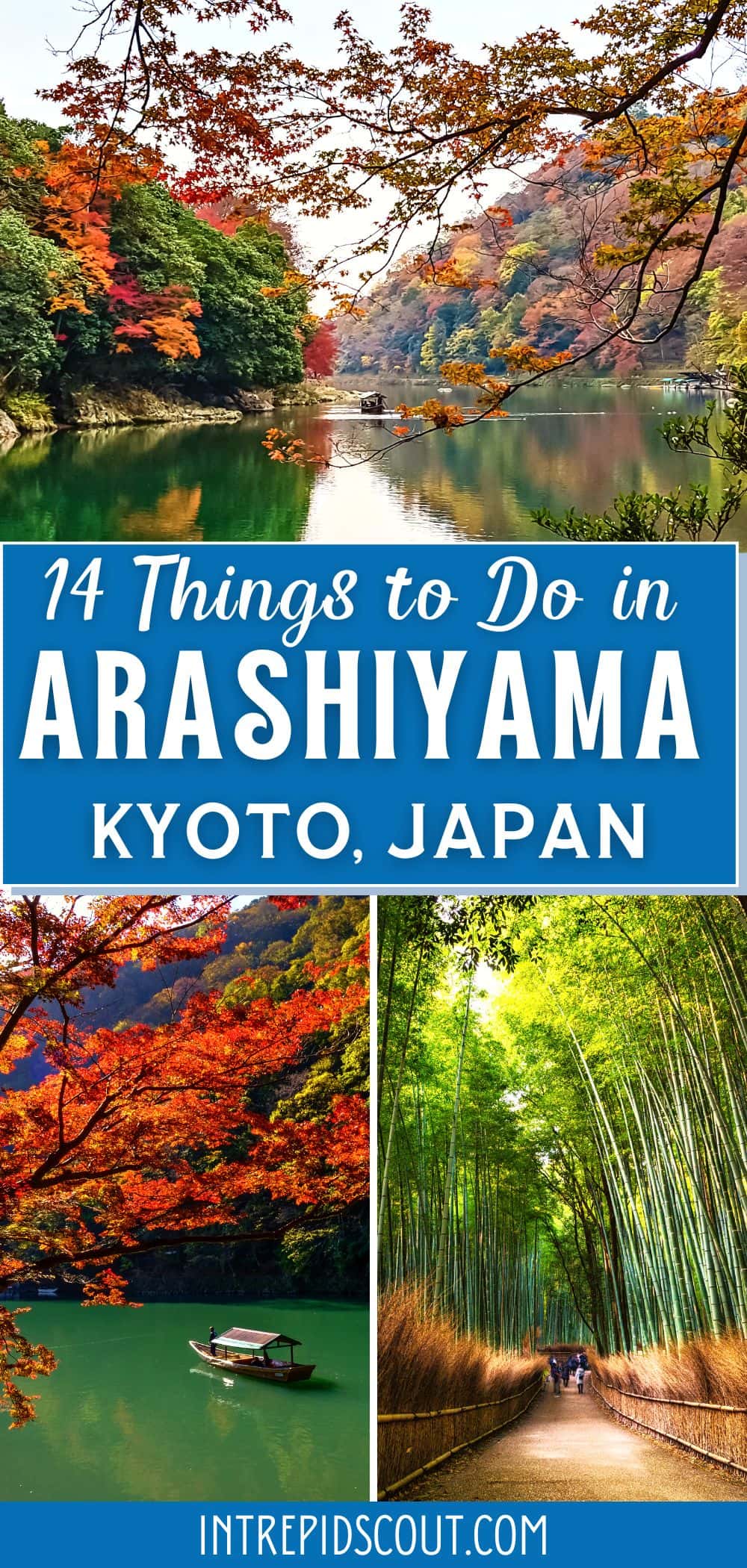
Now, It Is Your Turn, I Would Like to Hear Back from You!
Are you planning your trip to Kyoto? Are you going to visit Arashiyama?
Please let me know! Drop me a quick comment right below!
Click on any of the images below to get inspired and to help you with the planning process with your trip to Kyoto!
More Information About Kyoto and Other Stunning Places in Japan:
WHAT to EAT at Osaka KUROMON MARKET – 10 Culinary Experiences You Can’t Miss
First Visit to Kyoto – How to Visit and What to See (11 Things You Can’t Miss)
Perfect Day Trip to Miyajima from Kyoto, Osaka, or Hiroshima
2 Days in Kyoto: The Perfect Kyoto Itinerary
10 Amazing Things to Do in Hiroshima on Your First Visit
Read All the Posts About Japan in:
Japan Travel Guide
- alert('URL copied to clipboard.')).catch(err => console.error('Unable to copy to clipboard.', err))">
Share via Email
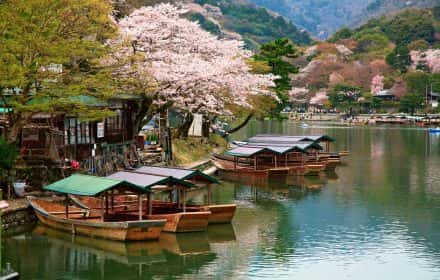
7 Fun and Easy Trips from Kyoto (Maps+Useful Tips)
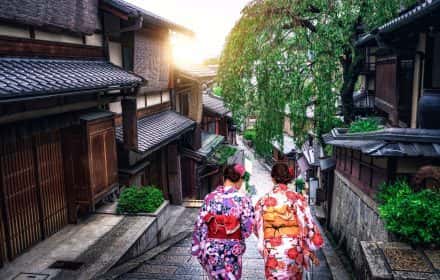
14 Valuable TIPS for FIRST-TIME VISITORS to KYOTO
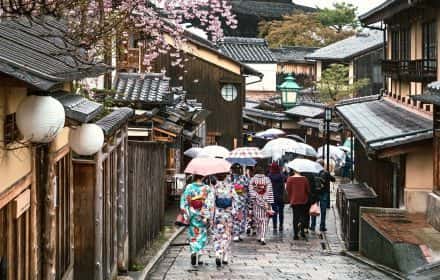
8 THINGS You Can't Miss - Perfect 2 DAYS in KYOTO
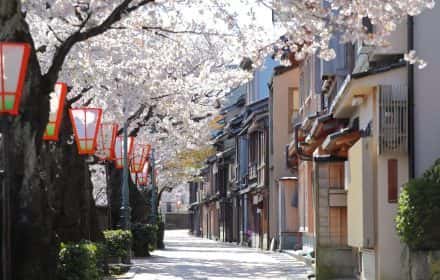
Perfect ONE DAY in KANAZAWA - 7 Things to Do (BEST TRIP from Tokyo, Kyoto, or Osaka)
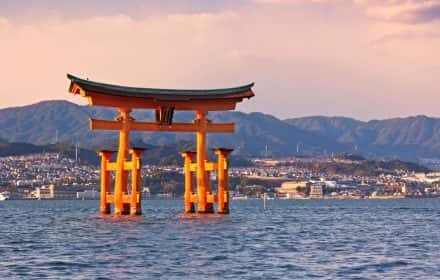
Perfect DAY TRIP to MIYAJIMA from Kyoto, Osaka, or Hiroshima (9 Things to Do)
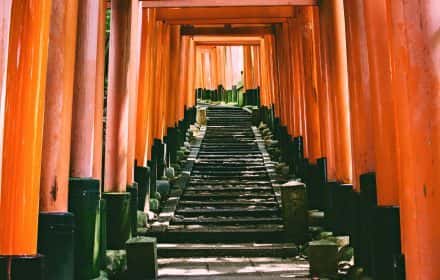
Amazing FUSHIMI INARI TAISHA in Kyoto (8 Things to Know Before You Visit)
@intrepid.scout
43 thoughts on “ 14 Amazing THINGS to DO in ARASHIYAMA, Kyoto (Map+Useful Tips) ”
I’ve just visited here! The bamboo forest was amazing! Great post ?
Hi Hannah! Thank you for your comment! I am so glad you got to visit Arashiyama. It is a great place to explore. Good luck in your travels! Anna
We only did Sagano Romantic Train, Bamboo Forest and Tenryu-ji while at Arashiyama. Such a serene place and I would love to climb up Jojakkoji Temple to catch the view from Mount Ogura next time!
Hey Dan! Thank you for your comment! There is so much to do in Arashiyama that it is hard to get it all done in one day. Maybe you can go back and re-visit one day?
Oh wow, such an exotic place! This must have been kind of a dream come true to visit this magical fairytale 🙂
And may I just say, I absolutly adore your blog, you have found a great way to tell your stories! 🙂
Thank you, Ann! So very kind of you!
Didn’t have enough time to visit Arashiyama on my last trip to Japan. From these suggestions, I wish I had. Would love to visit the Bamboo Grove. I always do touristy stuff early too to avoid crowds.
Well, now there is a reason for you to go back! It will be all worth it!
Wow, there certainly is a lot to do here. Did you do this all in a day? Was this combined with a multi-city vacation? Thanks for sharing this detailed list. I like all the details that you took the time to share, especially the prices and the hours of operation.
It is a list of all the possibilities worth looking into. However, I got it all done in one day. The distances are all walk-able and the sites do not take a lot of time. I always try to include the opening hours and the cost. It helps other travelers plan better trips. Thank you for your comment!
I wish I had this guide when I visited Kyoto, I had no idea the bamboo forest was THAT CLOSE and I missed it 🙁 next time right?! great post
Oh no! Arashiyama is great for a visit while in Kyoto. As you said, next time!
Great list! There is heaps and heaps of useful information here for itinerary planning!
Thank you so much, Melissa!
All the bamboo really surprised me. It’s beautiful. And I would love to walk across the Moon Crossing Bridge!
Sharon, the entire Arashiyama area is worth a visit. Bamboo forest is a highlight, but besides the forest, there is so much to do!
That bamboo forest would be worth getting up early for. Bet it was fabulous to wander around. I’d love to take my watercolors and try and capture it.
It must be done early in the morning. Otherwise, it gets very crowded. It really is one of those unmissable places!
Never had the willing of visiting Kyoto but, it looks so romantic. Thanks for the post 🙂
Thank you for your comment, Agnese! Kyoto is a great place to explore. There is so much, it will keep you busy for days. And, don’t miss Arashiyama!
The rickshaws look quiet interesting. I wonder how long the tour takes. I love the bamboo forest too, I would not mind going there on a walking trail.
The rickshaw ride can be 30-minute affair or you can go for longer rides. They are fun, but expensive.
I went to Japan many years ago but didn’t make it here, and never heard about it before now. Wow, this looks beautiful.I was in Kyoto though and managed to get through that hole in the giant wood column which apparently was good… 😉
Hey Heather! Would it be possible that you are referring to Nara? And if so, wow, I am impressed!
Yes ! I went to Kyoto and Nara. There’s a wooden Buddha and I remember crawling through this small hole to see if I’d find love our something like that lol!
Ha ha ha! You are amazing! I was not brave enough to crawl through this narrow opening. I saw a couple of people get stuck in it. It is part of the experience and I hope it brought you some luck.
Lol thanks! It was years ago. I’d probably get stuck in it now but yes I am sure it brought me luck and made someone laugh that day. Or I hope so because really you have to be a bit crazy to crawl through that thing! ??
Crazy in a good way! and, it is what we will remember down the road!
That’s so true!
I spent an entire summer in Japan during college. My biggest regret is not making it to Kyoto. Someday I’ll go back. It looks so amazing!
Oh, lucky you! That must have been an awesome experience. And, as you said – Kyoto next time!
You will love it! I spent numerous hours feeding them and taking their pictures, instead of exploring Nara.
Those bamboo forests look amazing, my mum used to have a small bamboo plant in the garden and it sounded amazing rustling in the wind, I bet this sounds phenominal. What a peaceful place it looks.
Hey Becki! Thank you for your comment! I loved Arashiyama’s Bamboo Forest. It is a serene place and when the sun and a little wind hits the grove, it really becomes magical.
You are absolutely spot on with Arashiyama. Brought back many happy memories of my stay in Japan. Great tips.
Very well presented post. Loved it. Japan has always been on our list. Saving your post for future reference.
Thank you, Sana, for your comment!
Great and detailed post. Japan is truly a hidden gem.
I was there in April 2017, only knew about the bamboo grove, which I loved and the monkey park, which I declined to visit. Thanks for all the info. Next trip to Japan in 2021.
Great! I am glad you found it useful. Good luck with your next trip to Japan!
Hi Anna, this is Anna too. Great read and this piece is so informative. Our family has also caught the travel bug and can’t wait for the lock down to be over.
Hello Anna! Thank you so much. I am glad you found it useful. I know! I can’t wait to start exploring again.
Leave an answer Cancel reply
Your email address will not be published. Required fields are marked *
The company processes your data to facilitate the publication and management of comments. You can exercise your rights of access, rectification, deletion and objection, among others, according to our Privacy policy .
- Tours & Experiences
- Tailor-made Trips
- Bahasa Indonesia
We are happy to see you again!
Continue with
Or use email.
No Account? Create one
Create account
Already have an account? Sign in
Quickly Sign up with
I agree to Japan Travel's Terms of Service and Privacy Policy . Terms of--> and acknowledge that Japan Travel's Privacy--> applies to me.-->
Email reset password link
Please check your inbox and click the link we will send to you.
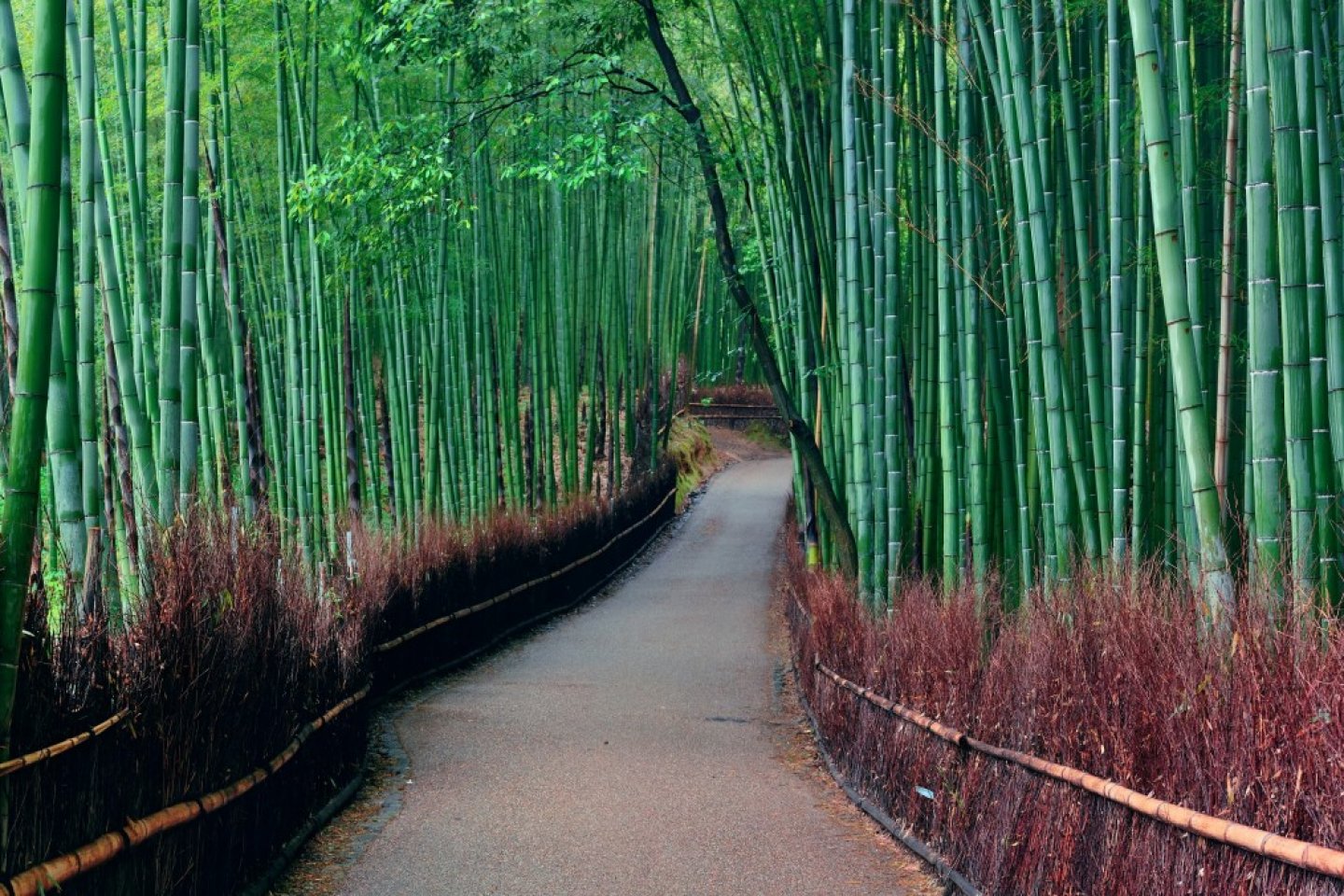
Bamboo forests in this western Kyoto suburb
Things to do in arashiyama.

Ninna-ji Temple

Adashino Nenbutsuji Temple

Okochi Sanso Garden
Upcoming arashiyama events.
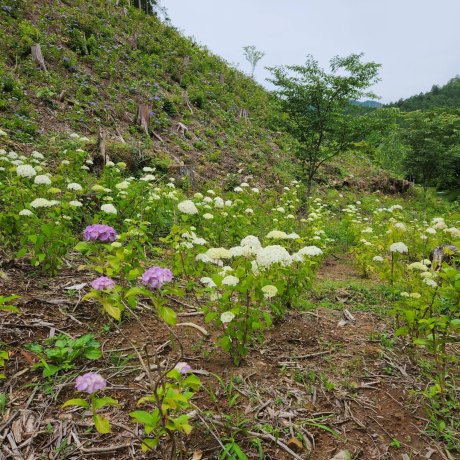
Kahoen Hydrangea Festival 2024
During peak hydrangea season, Kyoto's Kahoen garden is set to be filled with around 10,000 hydrangea bushes in bloom.
About Arashiyama
Along a river in the West of Kyoto lies Arashiyama, a rural suburb of Kyoto. Literally “Storm Mountain”, Arashiyama is actually a tranquil place where you can wind down and relax in a beautiful natural setting.
Arashiyama has its fair share of temples, or else it wouldn’t be Kyoto, but you might want to skip having a closer look and instead just stroll along the countryside lanes near the hillside to the northwest of Arashiyama.
These countryside lanes lead you through rice fields and bamboo forests and along the way you pass by some craft shops and cafes.
This is a most pleasant way to observe the scenery and watch the locals go about their business. Discovering Arashiyama at leisure like this can easily take you a whole day.
The heart of Arashiyama centers on Togetsu-kyo (Crossing Moon Bridge), which is a popular spot for cherry blossom viewing in spring and for maple leave viewing in autumn.
As the name suggest, the bridge might also be an ideal location for watching a glorious full moon in September. Since the Heian Period (794-1192) Japanese have enjoyed tsukimi (moon viewing).
During other seasons this wooden bridge in traditional architecture is nonetheless scenic against the backdrop of mountains on either side of the flowing water.
Organizers of pleasure boat tours have their piers on either side of the river near Togetsu Bridge. The broad river is also a good place where you can observe night-time cormorant fishing in summer.
The first stop of most bus tours to Arashiyama is Tenryu-ji Zen temple where the main attraction is not the temple building but the temple garden. A fee is charged just for visiting the garden but this is not something that deters Japanese garden connoisseurs who happily splash out the money. Some people prefer to view the garden from the terrace of Tenryu-ji and they swear that this is actually the best view.
If you have overdosed on visiting temples in central Kyoto, then skip Tenryu-ji and just make your way around the garden to its back where you will find a large bamboo groove.
Tall bamboo stalks slightly swaying back and forth and bamboo leaves rustling in the wind, this is the image and sound that best fits Arashiyama.
Most tour groups race through this peaceful place but it is worth a slow stroll with frequent stops to admire the gracefulness of the bamboo plants.
Having passed through the bamboo groove, a country lane runs along the foot of the mountains. Strolling along this lane you will pass by Jojakko-ji Temple first, followed by Nison-in Temple and finally Gio-ji Temple.
These temples are open from 9:00 to 16:00 all year-round. Visitors can enjoy the temple grounds nestled in the mountain side for a fee of yen 400, 500 and yen 300 respectively.
Don’t expect grandeur or anything exceptional; these small temples are rather unassuming and understated and their main attraction is the setting amidst the greenery of the forested mountain slopes.
Administratively, Arashiyama is the place in the south of the river while Sagano is the name of the area north of the river. To add to the confusion, the river that flows through the area is called Katsura River east of Togetsu Bridge and Hozu River west of the bridge. However, for touristic purposes the whole area is referred to as Arashiyama.
Walk along the river towards the south and you will come to a rather odd temple: its main attraction are crickets. Suzumushi Temple is the perfect place for lovers of these little creatures.
Come with your family, partner or friends for a relaxing day out in this leafy suburb of Kyoto. Arashiyama is worth a visit during all seasons, just avoid the stormy days...
Arashiyama Top 10
- Recommended

Jojakko-ji Temple

Causette Joli

Kyoto Bento Box Museum

Amanohashidate Chion-ji

Zuishin-in Daihonzan Temple

Kyoto Fall 2022 Day Three

Kyoto Fall 2022 Day Two

Kyoto Fall of 2022

Amanohashidate Motoise Kano Shrine

Iwatayama Monkey Park


The Kimono Forest Of Arashiyama

Kahoen Sakura Festival

The Bamboo Forest of Arashiyama

Kahoen Hydrangea Festival

Cycling Kyoto's Arashiyama

Okochi Sanso Gardens & Tea Room

Kyoto Arashiyama Koen Park

Otagi Nenbutsu-ji

Okochisanso Garden

Lost and Found in Arashiyama

Kyoto's Poet's House Rakushisha

Keishun-in Temple in Kyoto

Koryu-ji Temple in Kyoto

Hokongo-in Temple in Kyoto

Taizo-in Zen Garden, Kyoto

Where to eat in Arashiyama
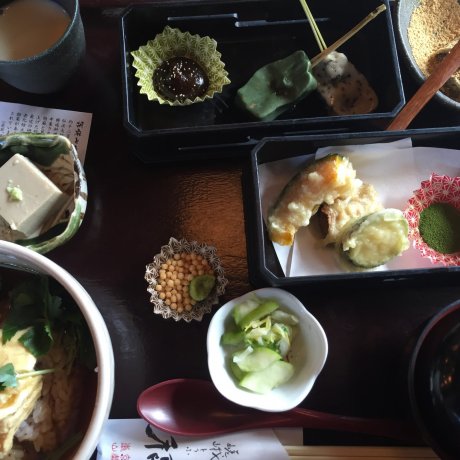
Yuba in Arashiyama
At Saga Tofu Ine in Arashiyama, yuba and tofu are served in many different ways. Some dishes are roasted, some are boiled, and some..

Nishiki by the Katsura River
Nishiki is a fine restaurant on the Katsura River in the Arashiyama area of Kyoto. It is a fine place to enjoy Kawadoko Ryori in..

Shigetsu Zen Cuisine
Shojin-ryori Zen Buddhist vegetarian cuisine at Tenryuji temple in Arashiyama, Kyoto is served to you by monks in a stunning picturesque..
Places to stay in Arashiyama
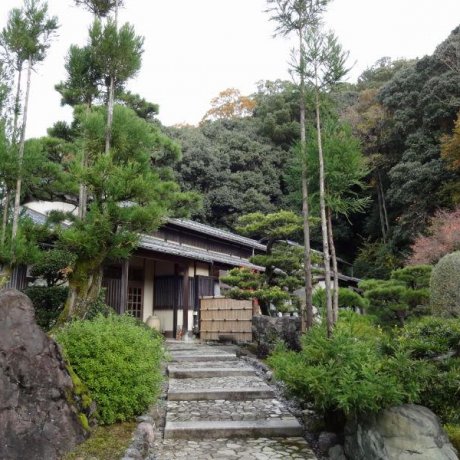
Ryokan Yamazaki
A hidden gem, Ryokan Yamazaki is worth the 30 minute bus ride from central Kyoto. Tranquil surroundings, hearty food and family..
Half-Day Arashiyama Day Trip from Kyoto, with Tenryu-ji and the Bamboo Grove

- Jojakko-ji Temple
- Tenryu-ji Temple
- Bamboo Grove
- Sogenchi Gardens
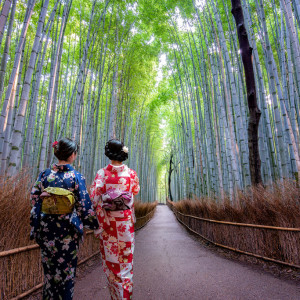
- From beliefs and customs, to paintings and literature, learn all about the Heian period's influence on Japanese culture
- Led by a local historian

- You're a culture lover interested in immersing yourself and your family in Japanese culture
- You’re hoping to discover Arashiyama through the eyes of a local expert
- Where does it meet? Where does it end? We meet near Hankyu Kawaramachi station. The tour ends in Arashiyama.
- Are the transport cost and temple entrance fees included in the tour cost? Yes, all the venue entrance fees and roundtrip train tickets from Kyoto are included.
- Can we use our JR pass on this tour? Unfortunately not - the only way for you to sit with the guide on the train is by using tickets bought directly by the guide, therefore you must purchase tickets through us.
- Is it okay to tip my guide in Japan? Yes. Context clients generally tip anywhere from 10-25% of the purchase price of a personal service such as this, depending on the quality of the experience and their tipping habits.
Reviews can only be left by Context customers after they have completed a tour. For more information about our reviews, please see our FAQ .
Book a Tour
- Our Experts
- Working with Context
- View All Cities
- Sustainable Tourism
- Refer a Friend for $50
- Travel Updates
- Advisor Login
- Expert Portal
Subscribe to our Newsletter
- Privacy Statement & Security
- Cancellation Policy
Arashiyama Half Day
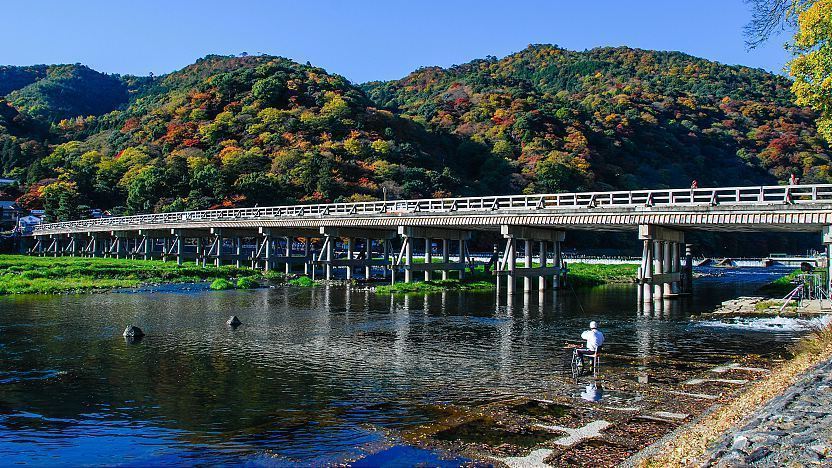
The following is a suggested half day walk through Kyoto 's Arashiyama District for medium paced travelers. The itinerary can be easily extended to a full day plan with a few additions .

Recommended Additions
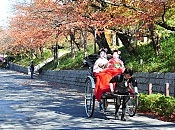
Kyoto Half Day Itineraries
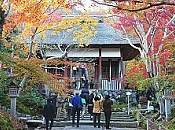
Jojakkoji and Nisonin
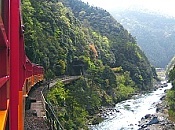
Sagano Scenic Railway
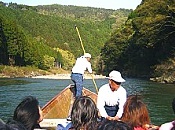
Hozugawa River Cruise
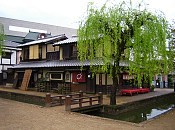
Toei Uzumasa Eigamura
Questions? Ask in our forum .
Hotels around Kyoto
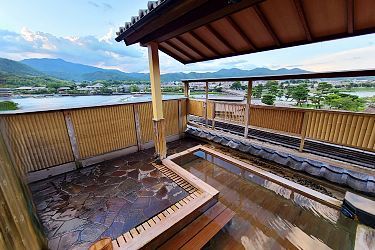
Experiences around Kyoto
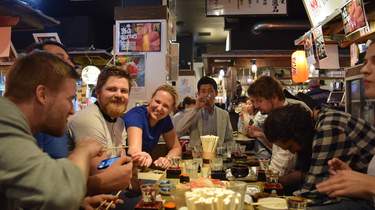
- Media & Industry
- Meetings & Events
- Select Language 简体中文 繁體中文(香港) 繁體中文(臺灣) India (English) Bahasa Indonesia 한국어 ภาษาไทย Tiếng Việt Singapore (English) Philippines (English) Malaysia (English) Australia/New Zealand (English) Français Deutsch Italiano Español United Kingdom (English) Nordic countries(English) Canada (English) Canada (Français) United States (English) Mexico (español) Português العربية Japan(日本語) Global (English)
- India (English)
- Bahasa Indonesia
- Singapore (English)
- Philippines (English)
- Malaysia (English)
- Australia/New Zealand (English)
- United Kingdom (English)
- Nordic countries(English)
- Canada (English)
- Canada (Français)
- United States (English)
- Mexico (español)
- Global (English)
- Fujiyoshida
- Shimonoseki
- Ishigaki Island
- Miyako Island
- Kerama Island
- Tokyo Island
- Koka & Shigaraki
- Hida Takayama
- Ginza, Nihonbashi
- Beppu & Yufuin (Onsen)
- Ginzan Onsen
- Nagasaki Islands

- Kumano Kodo
- Shikoku Karst
- Amami Oshima
- Hachimantai
- Omihachiman
- Aizuwakamatsu

- Diving in Japan
- Skiing in Japan
- Seasonal Flowers in Japan
- Sustainable Outdoors
- Off the Beaten Track in Japan
- Scenic Spots
- World Heritage
- Home Stays & Farm Stays

- Japanese Gardens
- Japanese Crafts
- Temple Stays
- Heritage Stays
- Festivals and Events
- Theater in Japan
- Japanese Tea Ceremony
- Cultural Experiences in Japan
- Culture in Japan

- Local Cuisine Eastern Japan
- Local Cuisine Western Japan
- Local Street Food
- Japan's Local Ekiben
- Japanese Whisky
- Vegetarian and Vegan Guide
- Sushi in Japan Guide
- Japanese Sake Breweries

- Art Museums
- Architecture
- Performing Arts
- Art Festivals
- Japanese Anime and Comics
- Japanese Ceramics
- Local Crafts

- Scenic Night Views
- Natural Wonders
- Theme Parks
- Samurai & Ninja
- Iconic Architecture

- Wellness Travel in Japan
- Japanese Ryokan Guide
- A Guide to Stargazing in Japan
- Relaxation in Japan
- Forest Bathing (Shinrin-yoku)

- Experiences in Japan
- Enjoy my Japan
- National Parks
- Japan's Local Treasures
- Japan Heritage
- Snow Like No Other
- Wonder Around Japan

- Visa Information
- Getting to Japan
- Airport Access
- COVID-19: Practical Information for Traveling to Japan
- Anime Tourism
- Countryside Stays
- Accessible Tourism
- Hokkaido Great Outdoors
- Scenic World Heritage in Tohoku
- Shikoku’s Nature and Traditions
- Southern Kyushu by Rail

- Traveling by Rail
- How to Travel by Train and Bus
- JR Rail Passes
- Scenic Railways
- Renting a Car
- Sustainable Travel in Japan
- Travel Brochures
- Useful Apps
- Online Reservation Sites
- Eco-friendly Accommodation
- Luxury Accommodations
- Traveling With a Disability
- Hands-free Travel
- How to Book a Certified Tour Guide
- Volunteer Guides
- Tourist Information Center

- Japanese Manners
- Spring in Japan
- Summer in Japan
- Autumn in Japan
- Winter in Japan
- Cherry Blossom Forecast
- Autumn Leaves Forecast

- Japan Visitor Hotline
- Travel Insurance in Japan
- Japan Safe Travel Information
- Accessibility in Japan
- Vegetarian Guide
- Muslim Travelers
- Safety Tips

- JAPAN Monthly Web Magazine
- Arts & Cultures
- Nature & Outdoor
- Festivals & Events
- Insider Blog
- Things to do
- Local Guides
- Food & drink
- Traditional
- Hokuriku Shinetsu

My Favorites
${v.desc | trunc(25)}
Planning a Trip to Japan?
Share your travel photos with us by hashtagging your images with #visitjapanjp
- Sagano & Arashiyama
Arashiyama 嵐山
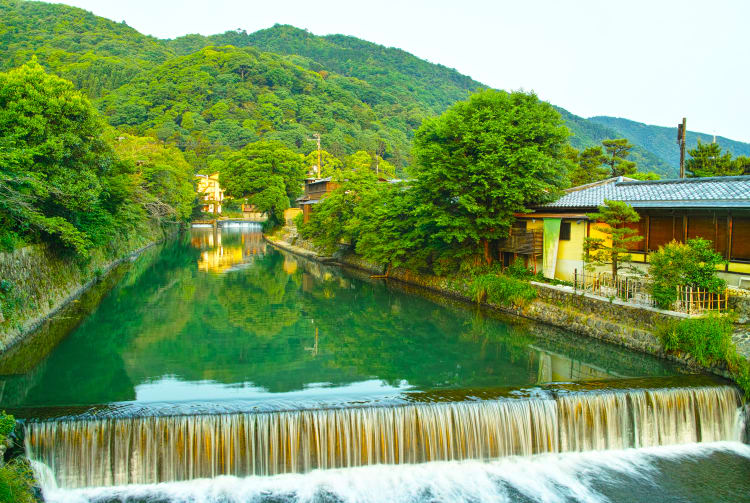
Ukyo-ku, Kyoto-shi, Kyoto-fu
- View on Google Maps
- Get Transit Info
Renowned for its bamboo grove, beautiful location and famous heritage
Located in the northwestern area of Kyoto, Arashiyama draws many visitors for its world-renowned bamboo grove and beautiful scenery that changes with each season. The area is dotted with temples, old imperial villas, and famous historical sites, many of which are National Treasures, or have been recognized as World Heritage sites. The entire region is designated by the Japanese government as a Place of Scenic Beauty.
- Togetsukyo Bridge—the great wooden landmark
- Walking among the towering stalks of Arashiyama Bamboo Grove
- Tenryu-ji—one of the greatest Zen temples of Kyoto
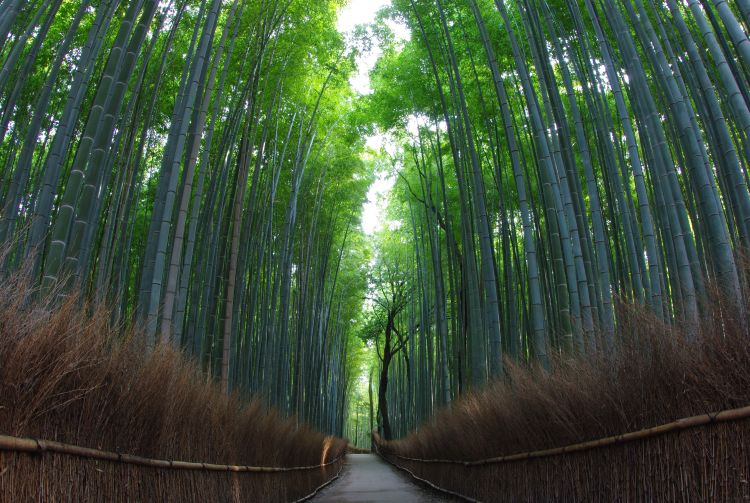
How to Get There
It can be reached on one of three railway lines: the JR Sagano Line which serves Saga Arashiyama Station; the Hankyu Line to Arashiyama Station; or the Keifuku Randen Tram Line.
Quick Facts
In the 13th century, Emperor Go-Saga had Yoshino's famous cherry trees moved here, making the area popular for cherry blossom viewing
There are light ups through out the year, where colored beams are thrown upon the hillsides and the over the top of the Arashiyama bamboo grove
The views from the top of the Iwatayama Monkey Park offer a stunning perspective of the distant Higashiyama mountainscape
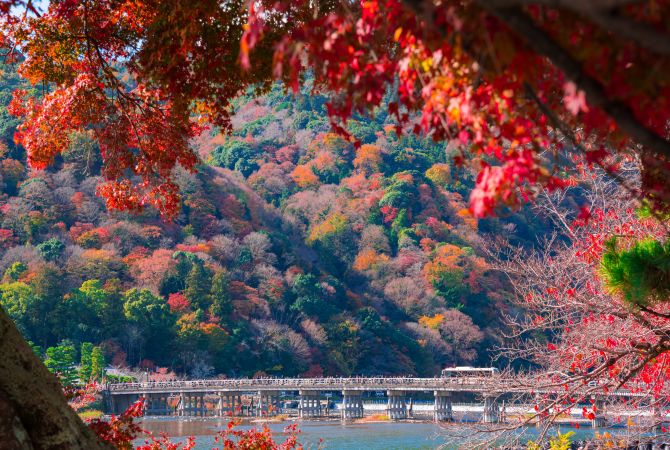
The poet's mount
Across from Arashiyama is Mt. Ogura, famed as the setting for the Ogura Hyakunin Isshu—a classical anthology of one hundred Japanese waka by one hundred poets who wrote one poem each. A card game adapted from the anthology is a popular and highly competitive pastime. Since ancient times, renowned poets such as Basho have pilgrimaged to Arashiyama.
Expansion outward to the natural world
Its garden is one of Kyoto's best, incorporating the surrounding mountains into its design, using the Japanese garden design concept of shakkei, or borrowed scenery. The exit at the back of the grounds leads directly to Arashiyama's world famous bamboo grove.
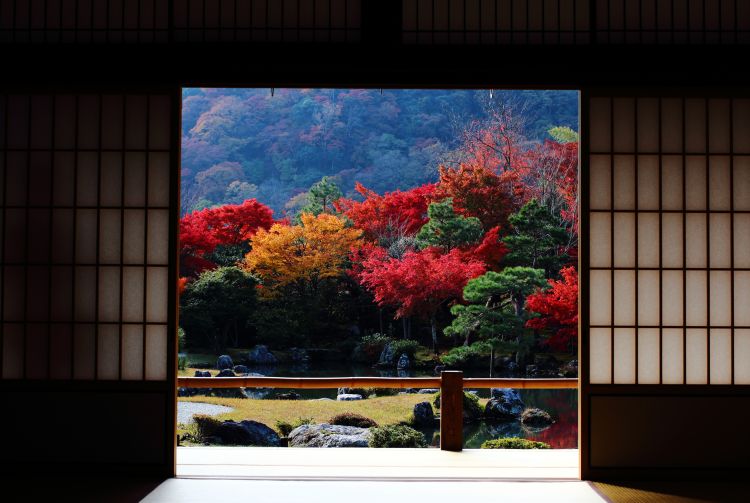
The promenade of heavenly bodies
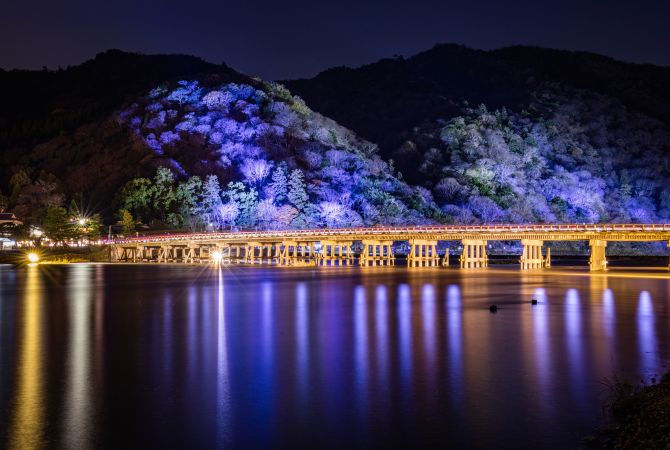
A journey up and down the river
A narrow-gauge train also runs along the river, and you should visit both to get a closer look at the ever-changing face of Arashiyama's natural landscape, celebrated by poets since ancient times.

An enjoyable visit to Arashiyama should be leisurely. Plan for a half or full day to take in the sights and not feel rushed through the idyllic setting.
* The information on this page may be subject to change due to COVID-19.
Recommended for You
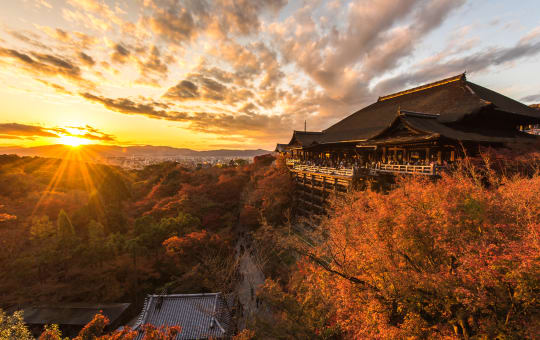
Please Choose Your Language
Browse the JNTO site in one of multiple languages

Private Van – Deep Kyoto & Arashiyama Tour (Full-English Guide)
- Guided , Kyoto , Private Tours , Tour Reviews
Set out on a journey that unveils the hidden treasures of Kyoto and Arashiyama with the ‘Private Van – Deep Kyoto & Arashiyama Tour (Full-English Guide)’.
This exclusive experience bookable on Viator takes travelers on a captivating exploration of these enchanting destinations. With a knowledgeable full-English guide by their side, participants can enjoy the rich cultural and historical wonders of Kyoto and the picturesque beauty of Arashiyama.
From the iconic Arashiyama Bamboo Grove to the majestic Kinkaku-ji Temple, every step of the itinerary promises to be a memorable adventure.
This introduction sets the stage for a captivating and informative article, inviting readers to discover the fascinating world of Kyoto and Arashiyama through this exceptional tour.
Great News! You can reserve your spot for free with Viator. You can easliy cancel any time up to 1 day before without paying anything.
Quick Takeaways
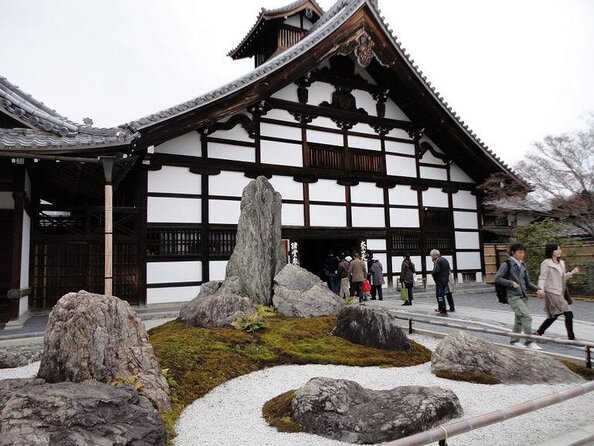
- The tour highlights include visiting the iconic bamboo grove in Arashiyama and experiencing the tranquility and awe of walking through the towering bamboo stalks.
- The Arashiyama Bamboo Grove holds cultural significance in Japan as a symbol of strength, flexibility , and resilience.
- The tour offers the opportunity to explore traditional temples, charming streets lined with old wooden houses, and learn about the rich history and traditional way of life in Kyoto.
- The itinerary includes visits to historical sites such as Kinkakuji Temple and Nijo Castle, as well as immersive cultural experiences like the traditional tea ceremony and witnessing traditional crafts being practiced and preserved in workshops.
Not for you? Here's a few more great tours and experiences nearby.
Private Airport Transfer Kansai Airport in Kyoto Using Hiace
- Samurai Experience & Kenbu Show in Kyoto
- Perfect 4 Day Sightseeing in Japan
- Osaka Kansai Airport (KIX) to Kyoto – Arrival Private Transfer
Tour Highlights
One of the tour highlights includes visiting the iconic bamboo grove in Arashiyama. This beautiful natural attraction is a must-see for anyone visiting Kyoto. As you walk through the towering bamboo stalks, you’ll feel a sense of tranquility and awe.
The bamboo grove isn’t only a popular tourist spot, but it also holds cultural significance in Japan. It’s a symbol of strength, flexibility , and resilience.
Along With the bamboo grove, the tour offers other hidden gems that provide a unique culture experience. From exploring traditional temples to strolling through charming streets lined with old wooden houses, you’ll get a taste of the rich history and traditional way of life in Kyoto.
This tour is perfect for those looking to delve deeper into the beauty and heritage of Kyoto.
Itinerary Overview
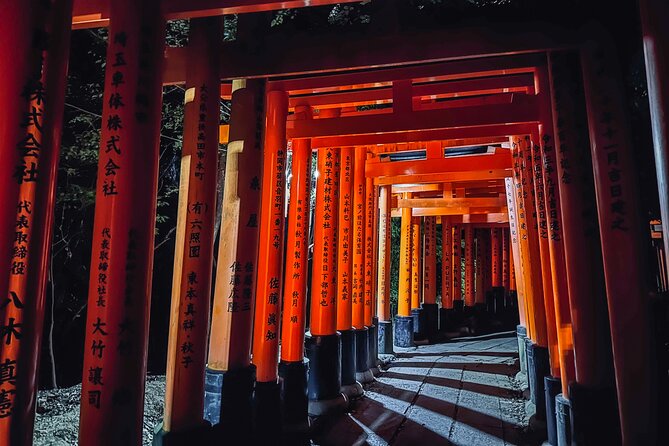
The itinerary overview for the Private Van – Deep Kyoto & Arashiyama Tour includes a detailed schedule of the attractions and activities that will be covered during the tour.
- Historical significance : The tour will take visitors to historical sites such as Kinkakuji Temple, also known as the Golden Pavilion, which showcases the beauty of traditional Japanese architecture. Plus, you will have the opportunity to explore Nijo Castle, a UNESCO World Heritage site that served as the residence of the Tokugawa shoguns.
- Cultural immersion : The tour provides a chance for culture through visits to the Arashiyama Bamboo Grove, where visitors can experience the tranquility of nature and the sound of rustling bamboo. Participants will also have the opportunity to partake in a traditional tea ceremony, allowing them to learn about and appreciate the art of tea preparation.
- Arashiyama exploration: The itinerary includes a visit to the Arashiyama Monkey Park, where visitors can observe and interact with Japanese macaques in their natural habitat. In addition, you will have time to explore the scenic Arashiyama district, known for its picturesque Togetsukyo Bridge and charming streets lined with shops and restaurants.
Deep Kyoto Exploration

Deep Kyoto Exploration begins with an immersive journey into the rich history and cultural heritage of this captivating city.
One of the highlights of this exploration is a visit to the enchanting Kyoto gardens . These meticulously designed gardens are known for their tranquil beauty and are a perfect place to experience the harmony between nature and human creativity.
Along With the gardens, the tour also includes a visit to workshops where traditional crafts are practiced and preserved. Here, visitors can witness skilled artisans creating stunning pottery, weaving intricate textiles , and crafting delicate ceramics. This hands-on experience allows visitors to gain a deeper appreciation for the time-honored craftsmanship that’s synonymous with Kyoto.
Arashiyama Bamboo Grove
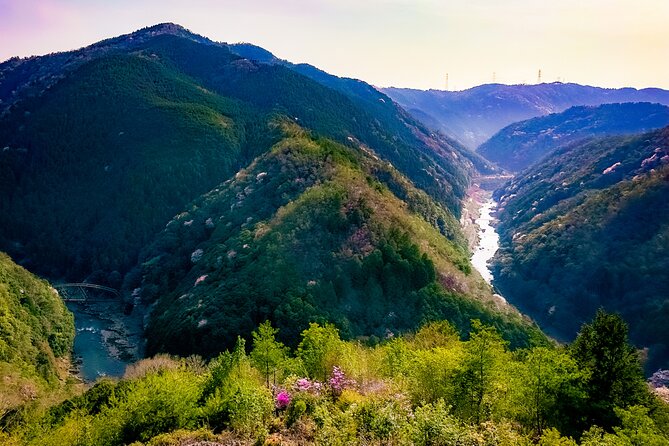
Visitors can explore the serene beauty of Arashiyama Bamboo Grove during their Deep Kyoto & Arashiyama Tour. Here are three key points about this iconic destination:
- Historical significance : Arashiyama Bamboo Grove holds great historical importance in Kyoto. It has been a popular destination for centuries, known for its tranquil atmosphere and stunning bamboo forest. The grove is considered a national treasure, with its towering bamboo stalks creating a picturesque setting that transports visitors to another time.
- Bamboo crafts : The grove isn’t only a sight to behold but also a place where visitors can appreciate the art of bamboo crafts . Many local artisans have mastered the skill of working with bamboo, creating intricate baskets , utensils , and even furniture. Exploring the grove gives visitors a chance to admire these beautiful creations and perhaps even purchase a unique bamboo souvenir.
- Natural beauty: Arashiyama Bamboo Grove is a nature lover’s paradise. The rustling sound of the bamboo leaves in the wind creates a soothing ambiance, making it a perfect spot for relaxation and meditation. Walking through the grove’s winding paths, visitors can enjoy the beauty of nature and find inner peace amidst the towering bamboo stalks.
Kinkaku-ji Temple Visit
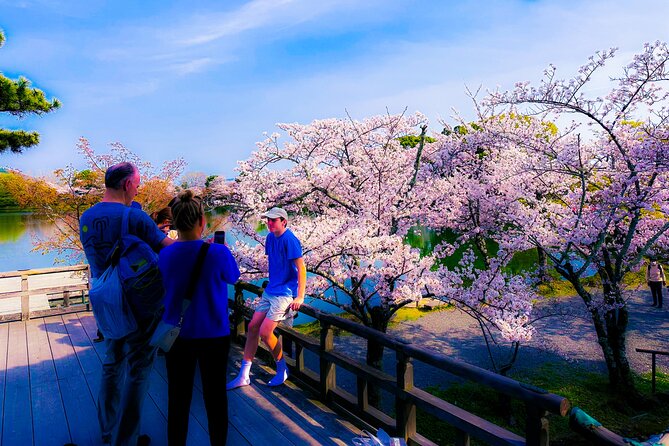
During the Deep Kyoto & Arashiyama Tour, visitors have the opportunity to visit the iconic Kinkaku-ji Temple.
Kinkaku-ji, also known as the Golden Pavilion, is a Zen Buddhist temple located in Kyoto, Japan. The temple is renowned for its stunning architecture and rich history. Originally built in 1397, Kinkaku-ji has undergone several reconstructions over the years.
The top two floors of the temple are covered in gold leaf, giving it its distinctive appearance and earning it the nickname ‘Golden Pavilion.’ The lower floors are built in the Shinden-zukuri style, which was popular during the Heian period.
The temple is surrounded by a beautiful garden with a large pond, providing a serene and picturesque setting for visitors to enjoy.
Local Cuisine Experience
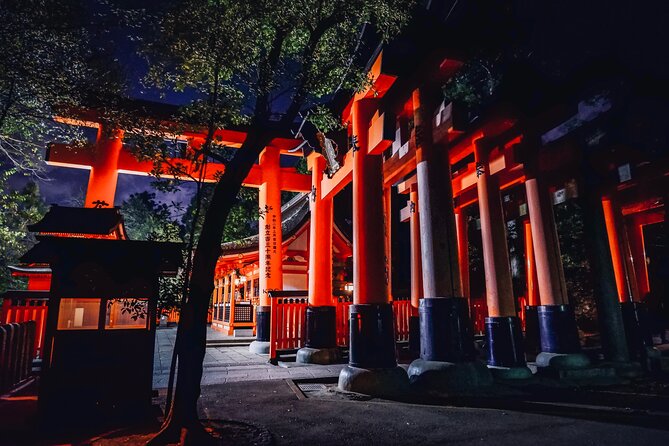
The tour offers visitors an opportunity to indulge in a local cuisine experience. Here are three highlights of this culinary adventure:
- Local food recommendations : The tour takes participants to hidden gems and local eateries where they can savor authentic Kyoto cuisine. From traditional Kyoto-style kaiseki meals to mouthwatering street food like takoyaki and yudofu, visitors can enjoy the flavors of the region. The knowledgeable guide will provide recommendations based on personal preferences and dietary restrictions.
- Cooking class opportunities : For those looking to not only taste, but also learn how to prepare local dishes, the tour offers cooking class options. Participants can join a hands-on session with expert chefs and learn the secrets behind creating traditional Kyoto dishes. Whether it’s making sushi, tempura , or matcha sweets , these classes provide a unique opportunity to delve deeper into the local culinary culture.
- Insider insights: Throughout the tour, the guide shares fascinating stories and insights about Kyoto’s food culture. From the historical significance of certain ingredients to the rituals behind tea ceremonies, you will gain a deeper understanding of the connection between food and Japanese traditions. These insights add an enriching layer to the overall experience, making it not just a meal, but a cultural journey.
Private Van and English Guide
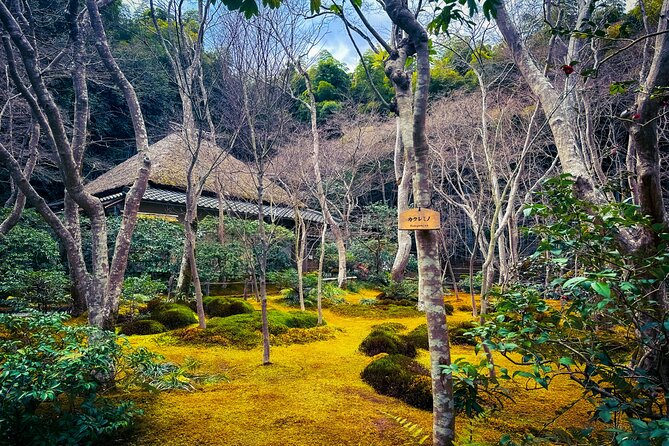
Participants on the Deep Kyoto & Arashiyama Tour have the option of enjoying a private van and an English guide throughout their journey.
Hiring a private van and guide for a tour offers several benefits. First, it allows for a more personalized and flexible experience. The guide can tailor the tour to the participants’ interests and preferences, ensuring a unique and enjoyable experience.
Second, having a private van provides convenience and comfort. Participants can travel in style and have the freedom to explore different attractions without the hassle of public transportation.
To communicate effectively with an English-speaking guide, it’s important to speak clearly and ask for clarification if needed. It’s also helpful to use simple language and gestures to convey information.
Booking and Pricing Information
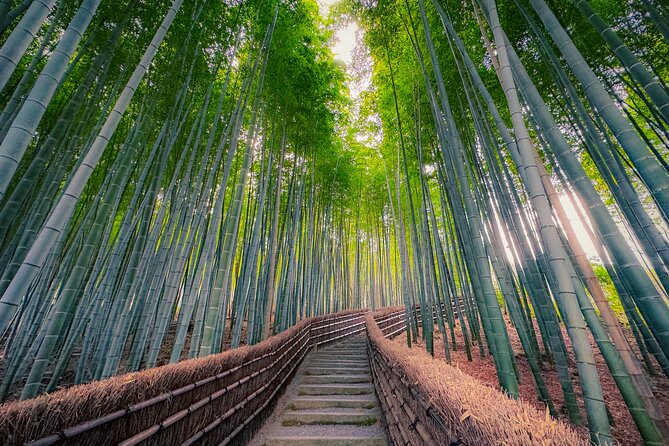
Visitors interested in booking the Deep Kyoto & Arashiyama Tour with a private van and English guide can find detailed pricing information and booking options on the Viator website.
Here are three key points to know about the booking and pricing:
- Cancellation Policy : If you need to cancel your tour, a full refund is available if you do so at least 24 hours in advance. However, if you cancel less than 24 hours before the start time, no refund will be given. It’s important to note that changes made less than 24 hours before the start time aren’t accepted.
- Traveler Photos Availability : You can find more traveler photos of the tour on the Viator website. These photos can give you a better idea of what to expect and help you make an informed decision.
- Pricing: The Deep Kyoto & Arashiyama Tour starts from $255.10. For more information on pricing and to book your tour, visit the Viator website.
Frequently Asked Questions
What is the maximum number of participants allowed on the tour.
The maximum number of participants allowed on the tour is subject to tour capacity and group size restrictions . There is a tour participant limit , which ensures a comfortable and enjoyable experience for all.
Are Entrance Fees to Attractions Included in the Tour Price?
Entrance fees to attractions are not included in the tour price. However, meals are provided during the tour. Travelers are also allowed to bring their own snacks on the tour.
Is Transportation Included From and to My Hotel?
Yes, transportation from and to your hotel is included in the tour. The tour provides convenient hotel pick up and drop off, ensuring a hassle-free experience for the travelers.
Can the Tour Be Customized to Include Specific Attractions or Activities?
Yes, the tour can be customized to include specific attractions or activities. The guide will provide recommendations based on your preferences and ensure that your tour is tailored to your interests.
Is There a Minimum Age Requirement for Participants on the Tour?
There are no age restrictions or minimum age requirements for participants on the tour. People of all ages are welcome to join and enjoy the Private Van – Deep Kyoto & Arashiyama Tour.
To sum it up, the private van – deep Kyoto & Arashiyama tour offers travelers a unique and immersive experience through the cultural and historical wonders of Kyoto.
With a full-English guide and a seamless itinerary, participants can explore deep Kyoto, visit the mesmerizing Arashiyama Bamboo Grove, and experience the Kinkaku-ji Temple.
The tour also includes a taste of local cuisine and the convenience of a private van.
Don’t miss out on this exclusive journey, starting from just $255.10.
Related Posts

- December 31, 2023

Private Miyajima Oyster and Sakurao Whisky Distillery Tour

Seasonal Shuttle to Minami-Sado
Trending now.

- Japan Navigator
Arashiyama, Kyoto
Be mesmerized by the beauty of Kyoto Prefecture's Arashiyama in its full autumn colors. This area attracts visitors from around the globe. Explore its highlights on an ultimate two-hour condensed course.
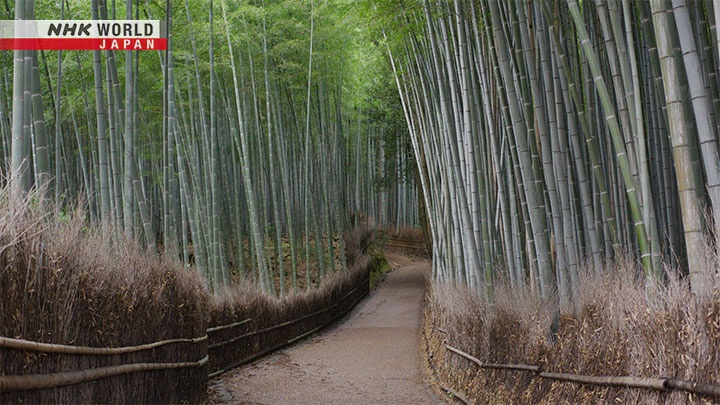
I just love this scenery.
The autumn colors are amazing.
Kyoto's Arashiyama, famed across Japan for stunning autumn leaves;
has a beauty that really comes into its own from mid-November.
And that's where we're going!
I can't wait! What're we going to see?
My father's visiting me in Japan, and I'm showing him around. So...
The perfect itinerary - two hours of the best sightseeing with lots of things to see and do.
Two hours? Doesn't sound like much...
No worries. Just leave it to me!
We'll be using this route map.
Even if you can't visit, you'll still get a taste of the journey's essence!
Sounds like a plan!
We'll also have some cool animation, and stories of old Japan.
Oh! Samurai days!
This is the Perfect 2-Hour Guide to Arashiyama, world-famous for its natural and historic beauty.
I'm raring to go!
Let's go Dad!
The Arashiyama area is about 10 kilometers west of Kyoto Station.
- We could go by taxi or bus, but let's take a streetcar. - Oh!
The streetcar line has been running for over a century.
Well, did you know there's an even older one in New Orleans. It's so...
- Sorry Dad, we need to check the route map. - Oh...OK.
Our two-hour tour of Arashiyama will be divided into three areas.
Area One features two popular tourist spots; Tenryuji Temple and Togetsukyo Bridge.
The autumn leaves are something to see.
Area two has an awesome bamboo forest.
We'll visit a wonderful temple, and hear a tale of samurai friendship from long ago.
Area three will feature the birthplace of many famous haiku poems.
Our final stop - an amazing garden built by a leading prewar Japanese film star.
- Then, come on! Let's get going! - OK, OK!
Our action packed 2-hour journey to savor the charm of Arashiyama to the fullest starts now, Dad!
Finally! We're off!
We'll get off the streetcar at Arashiyama Station.
- Cross the street and turn right. - OK.
Two minutes later we reach the gate of Tenryuji Temple. It's a World Heritage site.
Oh, that's impressive.
Our first must-see is through the gate.
My, my! Autumn leaves everywhere, all the way up the mountain!
The temple was built in the 14th century.
On the left, we have Mt. Arashiyama. That's how the area got its name.
Look at all the maple trees!
The red leaves are incredible.
Aren't they? Just gorgeous!
- This temple alone has 300 maples. - Remarkable!
Another three-minute walk, and we can see the entrance to the main hall.
Let's go inside.
I'm right behind you!
We'll need to get tickets first.
Well, let Daddy take care of that.
Oh, that building looks classic.
The temple was destroyed by fire several times.
This building dates to 1899.
Our next must-see is on the other side.
What a lovely garden.
Look, there's even a big pond.
There's also something special about this place.
The trees on the mountain seem to be a part of the garden.
You're right. It's like one big, continuous forest!
There's a trick of perspective, called "Shakkei" in Japanese found in many gardens and temples in Japan.
They say the view of autumn leaves from here to the mountain is the best in Arashiyama.
The garden was created by the temple's first abbot, Muso Kokushi.
He was considered a genius of garden design, and also helped spread Zen teachings in Japan.
And with this garden, he wanted to express the essence of Zen.
I "am" starting to feel more peaceful and calm.
Could it be that I'm channeling Zen directly?
Maybe. Who knows?
Our next must-see also has a connection with Muso Kokushi.
This figure in the great shrine is a statue of the 14th-century emperor Go-Daigo.
This temple was built by his enemy.
Wait. His enemy? That doesn't make sense.
Ashikaga Takauji built Tenryuji Temple.
He was a shogun, and a bitter opponent of Go-Daigo.
They waged several military campaigns against each other.
Their rivalry split the country in two.
After Go-Daigo's death in 1339, Takauji built the temple in his memory.
But why would he do something like that...
to honor an enemy he fought for so long?
Supposedly he did it on the advice of Muso Kokushi.
- Ah, the Zen abbot you talked about. - Right.
Muso Kokushi told him,
"Hatreds must not be carried into the next generation."
Ah-ha... Because of those teachings, this temple and that statue are here.
Those are pretty profound words, aren't they?
Yeah, they strike a chord, right to the heart.
There's one more must-see here. Let's visit the abbot's room.
This is just like a painting.
Those sliding doors frame the scene and bring everything into focus.
This "framing technique" is prominent in Kyoto's many gardens.
The autumn leaves seen from this building called 'Hojo' at Tenryuji Temple are especially famous.
Framing it makes the foliage even more striking.
Arashiyama's gardens are like masterpieces!
That was wonderful - the autumn leaves, the history, culture...
I'm up for our next destination!
Elapsed time is now around 15 minutes. Let's keep going.
Now, let's see the mountain that gives the area its name.
That's Mt. Arashiyama.
At its base, the Katsuragawa River.
You might hear it called the Oigawa River.
The mountain is steep, so the trees don't overlap each other.
You can see each one.
A truly breathtaking view.
I can see why this scenery is so popular!
People have been coming here for centuries to see the mountain and the river flowing past.
Long ago, aristocrats went on boating excursions here.
Hmm... Look there!
This 19th-century painting shows one of those excursions.
They'd bring poets and musicians, and compete to see whose boat was the most talented.
Elegance and luxury. And the perfect setting.
Mt. Arashiyama and the Katsuragawa River have been drawing tourists for a long time.
They sure have.
Elapsed time is now around 25 minutes.
The next must-see is on the Katsuragawa.
Isn't that bridge famous?
Togetsukyo Bridge is a symbol of Arashiyama.
There's been a bridge here for more than a thousand years.
This one is 150 meters long.
Does the name have a certain meaning?
"Togetsu" means "the crossing moon."
One moonlit night in the 13th century, the emperor was composing poetry here.
He said the moon seemed to be crossing the bridge - "togetsu."
They say that's how it got its name.
And a very romantic name, too.
Let's cross!
- Walk for one minute and...stop! - What?!
Now look right, Dad.
What's that round mountain?
It's another must-see.
Although it's just under 300 meters tall,
Mt. Ogurayama is a very important mountain for the Arashiyama area.
In fact, they say it's the reason the autumn leaves here are so famous.
In 1235, Ogurayama's autumn leaves became part of the Hyakunin Isshu.
- What's that? - The Hyakunin Isshu is a famous collection of 100 poems by 100 different poets.
There's a poem in it about this mountain.
"ogurayama mine no momijiba
"kokoro araba ima hitotabi no miyuki matanamu"
Translation please?
"Maple leaves that crown Mt. Ogurayama. If you have a heart,
I bid you wait for the emperor before you fall"
When the emperor heard this poem,
he was moved to come here to see the leaves with his own eyes.
The mountain's name spread all over Japan, and the rest is history.
Leave it to Japan - a poem, then a tourist spot.
Next must-see, Dad. It's near the bridge.
You're keeping me guessing.
This is the highlight of any Togetsukyo visit.
Mountain and bridge in a single frame.
That sums it up.
It almost looks designed for photographers.
That's it for Area One. How did you like it?
I liked it a lot! Arashiyama isn't just autumn colors.
There's so much history.
If you have time to spare, there's some other things to enjoy around here.
"Yudofu" is boiled tofu. One of Kyoto's representative dishes and a favorite in Arashiyama.
Originally a vegetarian cuisine for monks, tofu became a local standard.
It is said to be too soft to eat with chopsticks.
It warms your whole body. The tofu is very soft.
The weather is starting to get cold. This helps you stay cozy.
"Sakuramochi" This confection wraps sweet bean paste and rice cake in a fermented cherry leaf.
Often pink like spring cherry blossoms, Arashiyama's "sakuramochi" is white.
For Arashiyama's canvas of changing hues, white "sakuramochi" suits every season.
Rokuoin Temple.
Constructed 600 years ago. The temple walk is lined with moss and blazing colors.
Jojakkoji Temple.
This gate, flanked by Deva guardians, dates to the 14th century.
The temple is surrounded by fall foliage at the foot of Mt. Ogurayama.
All right Dad, let's explore Area Two.
I'm ready! What's in store for us?
You'll hear a tragic story, visit a famous power spot, and discover some samurai secrets.
Ooh! Can't wait!
Our route takes us north, up the main street toward a mysterious bamboo forest.
From there we'll visit a historic residence in a beautiful setting.
Area Two will take about 35 minutes to cover.
Elapsed time to this point is about 35 minutes.
- You're OK to keep going, right Dad? - Of course!
The first Area Two must-see is on the road back toward Togetsukyo Bridge.
There used to be a bridge here, called Kotokikibashi Bridge.
A koto is a Japanese harp, and kiki means "hear."
In other words, the bridge where a Japanese harp was heard.
There's a tragic story behind this spot.
Tell me more!
In the 12th century, a noblewoman named Kogo was famous for her beauty and her koto skills.
- Emperor Takakura fell in love with her despite already having a wife. - Oh!
Due to court politics, she went into hiding in Arashiyama, far from the Emperor.
- But the emperor couldn't forget her, so he sent his deputy, Minamoto no Nakakuni, to find her. - And!?
Kogo was nowhere to be found.
So by the light of the harvest moon, Nakakuni played his flute near the bridge,
hoping Kogo would answer him with her koto.
As if in answer, he heard the plucking of koto strings.
He discovered Kogo's hiding place and brought her back to Kyoto.
She bore the emperor a child.
But she was forced to take monastic vows by people at court who resented her.
- So the bridge that once stood here was an important part of that tragic love story. - It was.
- Now, I don't want you to get tired, Dad. - I'm fine!
But I have the solution.
Good morning!
What's this?
In Japanese, it's called a "jinrikisha."
Ah! A rickshaw.
Just pay the fare and take a seat.
Hey, the view from up here isn't bad.
All right, here we go!
Oh, that looks like hard work.
You'll find rickshaws at historic tourist spots all over Japan.
I recommend them for fun and comfort.
- How you doing, Dad? - Very relaxing! This is fun!
We'll turn here.
- Where are we headed? - Just one of the most popular spots in Arashiyama!
Really? Now I'm curious!
Wow. This is like another world.
The forest path is lined for 500 meters by tens of thousands of bamboo stalks.
It's a photographer's dream.
Yes, the forest is a tourist magnet.
Can our driver get around in here?
Sure. The rickshaw has its own bamboo forest path.
Hold on, we're going to sway a little.
Here's the rickshaw path.
All right, let's experience the forest.
True Japanese scenery.
Bamboo green calms the soul.
They say the local people took care to preserve the forest.
Look up! It's even prettier.
I also wanted to show you the hedge along the side of the path.
The hedge on the right is made from bamboo grass.
It looks simple, but the technique is a thousand years old.
This is the same scene that people saw in ancient times.
A scene with a thousand years of history.
I get why they worked hard to preserve it.
The rickshaw path ends here.
Ōkini is Kyoto dialect. It means "thank you."
Ōkini to you too!
Our elapsed time is now around 45 minutes.
And here's the next must-see!
You mean that wooden gate?
This gate is called a torii.
It's the entrance to Nonomiyajinja Shrine.
I've seen gates like this. But why is this one black?
They left the black oak bark exposed. It's the oldest style of torii.
I think I'm just starting to grasp how much history is all around me.
The black gate and the yellow ginkgo leaves - it's like time stopped.
Come on, let's take a look at the shrine.
Oh! Sure are a lot of tourists.
The shrine is actually a power spot. It's been popular for centuries.
Power spot? I have to see this.
Look Dad, to the left.
- A heart. - People come here to get lucky in love.
Oh, that's the power, eh?
I wonder what that couple in kimono prayed for.
Wish them luck.
Another must-see is on the grounds of the shrine.
There used to be a building here, called the Saiku.
What was it for?
It's the residence for Saio - unmarried female relatives of the imperial family.
They came here to purify themselves, so they could serve the gods at Shinto shrines.
They appear in Japan's most famous work of literature.
It's called the Tale of Genji, from around the 11th century.
- It follows the romantic relationships of an aristocrat named Hikaru Genji. - Oh!
A woman named Rokujo no Miyasudokoro fell in love with Genji
and used a curse to murder his wife, Aoi no Ue, out of jealousy.
Oh, sounds scary.
After that, Rokujo no Miyasudokoro was estranged from Genji and left Kyoto with her daughter.
The daughter became a Saio, and lived here with her mother at the Saiku.
I do feel a mysterious power here.
Today it's a power spot for romantic good fortune.
You can almost feel the joys and sorrows of people here, swirling around.
Let's take our rickshaw and head for the next must-see.
We turn left when we see the big temple.
- We'll get off here. Thank you, Ijiri-san. - ŌKINI!
This is Hokyoin Temple, the last one we'll visit in Area Two.
Our next must-see is in the temple!
This garden is lovely too.
The moss with fallen leaves is really special.
The garden here is another prime spot for fall visits.
I can see why.
It's like there's a multicolored canopy over our heads.
This temple is the work of pupils of Muso Kokushi, who designed Tenryuji.
The techniques of the master and the teachings of Zen come together in a way you can actually feel.
There's the main hall, in the center of the garden.
There's something to see inside.
I'm excited! This is a great tour!
As you enter the great hall, look to the left.
- I see. The framing technique, right? - Right.
The doors facing the garden frame the perfect view.
The room itself becomes an art gallery for autumn leaves.
Dad, you're starting to talk like a poet.
Thanks to Arashiyama.
It's so rare to find an area that offers so many different experiences.
The next must-see is in the garden.
Now, what are these two monuments?
They're actually the graves of bitter rivals.
No kidding!?
There was the Ashikaga clan and Kusunoki clan, who fought over the rightful lineage of the emperor.
Kusunoki Masatsura was killed in battle in 1348, fighting the Ashikaga forces.
His bravery became a legend for succeeding generations.
And what about the other guy?
Ashikaga Yoshiakira, the second Ashikaga shogun.
When he heard about Masatsura's character firsthand from a Buddhist priest, Yoshiakira asked to be buried next to him.
Two rivals, side by side for almost seven hundred autumns. Wow.
Elapsed time: about an hour and ten minutes. How was Area 2?
Stunning colors and fascinating tales from yesteryear. I'm impressed!
Great! Here's some other things to explore.
Sagano Romantic Train.
The train runs 7.3 kilometers between Saga Torokko and Kameoka Torokko Stations.
Along the way are stunning views of autumn foliage in the Hozugawa River gorge.
It's one of the most popular ways to see Arashiyama fall colors.
It was stunning. I'll never forget it.
The trip takes 25 minutes.
Sagano Romantic Train - Adult fare ¥880 Operates from Mar. - Dec. (exact dates vary annually)
It's time for our third and final area.
Perfect. What's in store?
Oh! These fall colors are so intense!
Our first stop is Nison-in Temple, at the foot of Mt. Ogurayama.
Then we'll visit a house that hasn't changed in over 300 years.
And the last stop will be a garden built by a leading prewar Japanese film star.
- Our fifty-minute route has a lineup of six must-see spots. - Lead on!
Elapsed time is about an hour and ten minutes.
Our first must-see is a temple called Nison-in.
- Beyond the gate, we'll see fall scenery that's as impressive as anything so far. - Indeed!
This walk offers some of the nicest views I've seen.
I'm with you on that.
- The hundred-meter walk is flanked by about 200 maples of different kinds. - Splendid.
Wait a minute? We have red leaves on the right, yellow on the left.
At the end of the walk, there is a white-walled main hall.
Oh, that's a beautiful kimono.
The entrance is on the left, Dad.
Wow, this temple is absolutely blazing with color.
You'll see the entrance in another 30 meters or so.
They say this gate used to be exclusively for the emperor's attendants.
Our must-see is in the main hall.
These images are enshrined here.
They're from the 13th century, in the Kamakura period.
- Other than the hands and clothes, they're almost complete reverse images. - You're right.
The Shakyamuni Buddha on the right delivers believers to the Pure Land.
The Amitabha Buddha on the left is waiting in the Pure land to welcome them.
The name "Nison-in" means "temple of two revered images."
Their faces are full of compassion.
Just seeing them is a healing experience.
Let's keep going.
Elapsed time is about one hour, thirty minutes.
I hope you're not tired, Dad.
Don't worry about me. Where are we off to next?
Another must-see, this time with a fruit theme.
The fruit of that tree!
- What kind of fruit? - You'll see.
This residence is called Rakushisha, the House Where Fruit Falls.
Fruit, as in persimmons.
Ah yes, persimmons.
There's an interesting story behind the name of this house.
Come on, let's go inside!
So what's so interesting?
The house is unchanged from the samurai era, more than 300 years ago.
Hmm. It does look pretty spartan.
The haiku poet Mukai Kyorai once lived in this house.
The story I mentioned, the one about persimmons, concerns some bad luck for Kyorai.
There were 40 persimmon trees in Kyorai's garden.
One autumn, he decided to sell the fruit to a Kyoto merchant.
But the night before, there was a storm.
All the persimmons fell to the ground!
That was bad luck!
Instead of getting upset, Kyorai wrote a poem about it.
It's on the monument in the garden.
Ah! This must be it.
Yes. This is the inscription.
"Kakinushi ya kozue wa chikaki Arashiyama"
"Above the persimmon trees, Mt. Arashiyama seems close at hand."
That is, with all the fruit gone, he could see the mountain clearly now.
So he was about taking life in stride.
Right, looking on the bright side.
Haiku poets in those days had the ability to sum up something deep in just a few words.
So Kyorai wrote a poem about his misfortune, and even named his house after it.
That's a poetic sense of humor.
I mean, really.
The garden is planted with flowers that often appear in haiku poems.
People even get together here for haiku readings.
Any ideas for a poem, Dad?
- Uh... Ok... Maple leaves... Maple Syrup... - Whoops, we'd better get going.
Our next must-see is on the far side of the square.
From here, you can see the house and garden as a whole.
It's like going back in time to the samurai era.
It's fun to imagine how quiet and peaceful Arashiyama was back then.
Matsuo Basho was Japan's most famous haiku poet.
He composed a poem during a visit here.
"Hitokitarazu shujitsu kanwoetari"
It means, "What a joy it is to have no visitors all day."
Arashiyama was a place to escape the madding crowd.
Perfect for composing poetry. You can feel it.
Our elapsed time is 1 hour 40 minutes.
This is our final tourist spot, Dad.
It's called Okochi Sanso.
We'll need tickets here too.
There's a must-see just three minutes' walk up this slope.
This Japanese garden is truly gorgeous.
It covers 20,000 square meters, about five acres, and has several separate gardens.
Look! They used "shakkei," that same trick of perspective again.
You're developing a good eye, Dad.
This reminds me of the garden at Hokyoin.
Red leaves on green moss. Magical.
You can enjoy the best of Japanese gardens in one place.
Truly a must-see!
Okochi Denjiro was a leading Japanese prewar film star.
He kept working on this garden for 30 years, until his death.
Why was he such a garden fan?
It's partly connected with the movies he made.
Back then, film stock was hard to preserve.
Scenes that everyone worked hard to film were destined to be lost.
They say Denjiro wanted to create something of beauty that would always remain.
The sign of a true artist.
So, Denjiro used each of the scenes in this garden as a way to express himself.
1 hour and 55 minutes have passed.
- One more must-see? - Of course.
Let's walk up the slope.
Here it is; the panoramic view from the hilltop terrace.
You can see the mountains that shield Kyoto from the east, and the city itself at their feet.
Truly beautiful.
It's been 2 hours, and we've seen so much!
We sure did!
Shall we review where we've been today, Dad?
Take it away!
In Area One, we saw Tenryuji Temple and its garden, and learned about its history.
We viewed the autumn leaves on Mt. Arashiyama and Mt. Ogurayama, and saw the Katsuragawa River.
In Area Two, we heard a tragic story about Kotokikibashi Bridge,
explored a mysterious bamboo forest and learned about more Japanese history.
In Area Three, we toured Nison-in Temple, Rakushisha, and the garden of Okochi Sanso,
and experienced the natural beauty of Arashiyama.
Two hours of all-you-can-see fun!
Kyoto's Arashiyama has it all:
fiery autumn foliage, stories of samurais and emperors, ancient poetry and literature.
The best of Japan's land and culture, all in one area.
Ōkini to my super-knowledgeable guide for a wonderful two hours.
I can't resist ending with another poem about Arashiyama, from the 11th century.
"Oigawa furuki nagare wo tazunekite
arashi no yama no momiji wozo miru"
It means, "To visit a river of history, to see autumn leaves in Arashiyama."
The perfect ending.
I'm really glad you enjoyed the tour, Dad.
Where shall we go next?
So many wonderful things to see!
We hope you'll come again on our next Perfect 2-hour Guide.
- Sayonara! - Sayonara!

IMAGES
VIDEO
COMMENTS
Located about 7km west of downtown Kyoto, Arashiyama is one of Kyoto's most popular sightseeing districts. The heart of the district is the Arashiyama Bamboo Grove, a mesmerizing grove of thousands of tall bamboo plants. A paved walkway runs through the middle of both sections, forming the famous "Bamboo Alley," one of Kyoto's most ...
8 hours. budget*. Around 4000 yen. pace. Average pace. * Budget includes approximate transportation costs and admission fees only. The following is a suggested full day itinerary for medium paced travelers through Kyoto 's Arashiyama District. The use of a rental bicycle is recommended as distances are considerable (about 10 kilometers).
Things to Do in Arashiyama. You can visit Arashiyama Monkey Park any day of the week from 9 am until 5 pm (March 15th through September 30th), or until 4 pm (October 1st through March 14th). The entrance ticket to Arashiyama Monkey Park is 600 yen for adults and 300 yen for children ages 4 to 15.
The one way ride to Saga-Arashiyama Station takes 15 minutes and costs 240 yen. From the station it is a 5-10 minute walk to central Arashiyama. By Keifuku Railway (Randen) The small trains on the Keifuku Arashiyama Line connect Arashiyama with Omiya Station at the intersection of Shijo Street and Omiya Street in central Kyoto (20 minutes, 250 ...
Check out Arashiyama's beautiful fall foliage colors between mid-November and early December. The leaves turn vibrant orange and red. Consider a guided tour or private guide to provide context, skip lines, and ensure you don't miss anything; Arashiyama Itineraries by Length Arashiyama Itinerary half day
Join our tour and embrace Arashiyama's spiritual awakening on foot and explore some hidden gems with our local guide. This walking tour of Arashiyama is unique because it offers a perfect combination of natural beauty, cultural heritage, and interactive experiences. From the serene Bamboo Grove to the Heritage Site of Tenryuji Gardens, the colorful Kimono Forest, the iconic Togetsukyo Bridge ...
Embrace Arashiyama's spiritual awakening on foot and explore some hidden gems with our local guide. This walking tour of Arashiyama is unique because it offers a perfect combination of natural beauty, cultural heritage, and interactive experiences. From the serene Bamboo Grove to the UNESCO World Heritage Site of Tenryuji Garden, the colorful ...
Walk through the famous Bamboo Grove and the ancient Tenryū-ji Temple. Rent a boat and row across the pristine waters of the Hozu-gawa area. Immerse yourself in local history and culture with the help of a guide. Full description. Take a short tram ride from Kyoto and become immersed in the scenic Arashiyama. Embark on a tour of the site where ...
from $167.80. Likely to Sell Out. Kyoto, Kyoto Prefecture. Deep Kyoto & Arashiyama Tour (Private Van - Full-English Guide) 8. from $243.21. Per group. Kyoto, Kyoto Prefecture. Kiyomizu Temple and Backstreets of Gion, Half Day Private Tour.
To sum it up, the Kyoto: 4-Hour Arashiyama Walking Tour offers a unique and immersive experience in the beautiful city of Kyoto. With a knowledgeable local guide, visitors can explore the lesser-known side of Arashiyama, visit stunning temples and shrines, and enjoy a delicious traditional lunch. With a maximum of 7 participants, this small ...
Arashiyama: Our most recommended tours and activities. 1. Kyoto: Full-Day Best UNESCO and Historical Sites Bus Tour. Discover Kyoto's must-see landmarks and World Heritages on the deluxe coach in 1day! In this tour we will take you to most famous places in ancient Kyoto such as Kiyomizu-dera Temple, Sanju-san-gen-do Temple, Arashiyama, Sagano ...
Kahoen Hydrangea Festival 2024. Jun 15th - Jul 7th. During peak hydrangea season, Kyoto's Kahoen garden is set to be filled with around 10,000 hydrangea bushes in bloom. 7 ¥300. View all events. Along a river in the West of Kyoto lies Arashiyama, a rural suburb of Kyoto. Literally "Storm Mountain", Arashiyama is actually a tranquil place ...
With a live tour guide who can speak English and Japanese, you can fully learn about the local culture and learn about the fascinating stories and legends of the area. Experience Highlights. Explore a lesser-known side of Arashiyama with a local guide and discover the hidden gems that make this walking tour a unique and immersive experience.
Discover the beauty and cultural richness of Arashiyama with the Kyoto Explore Arashiyama Walking Tour. Led by experienced guides, this half-day tour takes you on a captivating journey through the iconic Bamboo Forest, serene gardens, and a visit to the fascinating Monkey Park. Enjoy the tranquility of the Bamboo Forest, explore meticulously ...
The Arashiyama Walking Tour offers a captivating adventure through the charming district of Arashiyama in Kyoto, Japan. Led by local guides, participants can explore the iconic Bamboo Forest, where towering stalks create a serene atmosphere. They can also visit the Monkey Park, seeing the playful antics of monkeys in their natural habitat.
On our Arashiyama Tour, you travel back in time to this integral period of growth on an excursion to the quiet enclave of Arashiyama on the outskirts of Kyoto, visiting villas, temples, and unspoiled forests to unearth how Japanese identity came about during this fertile period. Meeting in front of Hankyu Kawaramachi Station, our guide will ...
The journey takes about 15 minutes. From Saga-Arashiyama Station, it's a 10-15 minute walk to the bamboo grove. The JR Pass covers this trip. By Bus: You can also take Kyoto City Bus number 28 from Kyoto Station to Arashiyama Tenryu-ji Mae, which is close to the bamboo forest. The ride takes about 30-40 minutes, depending on traffic.
3.5 hours. budget*. Around 1500 yen. pace. Average pace. * Budget includes approximate transportation costs and admission fees only. The following is a suggested half day walk through Kyoto 's Arashiyama District for medium paced travelers. The itinerary can be easily extended to a full day plan with a few additions.
Renowned for its bamboo grove, beautiful location and famous heritage. Located in the northwestern area of Kyoto, Arashiyama draws many visitors for its world-renowned bamboo grove and beautiful scenery that changes with each season. The area is dotted with temples, old imperial villas, and famous historical sites, many of which are National ...
With a full-English guide and a seamless itinerary, participants can explore deep Kyoto, visit the mesmerizing Arashiyama Bamboo Grove, and experience the Kinkaku-ji Temple. The tour also includes a taste of local cuisine and the convenience of a private van. Don't miss out on this exclusive journey, starting from just $255.10.
This is the Perfect 2-Hour Guide to Arashiyama, world-famous for its natural and historic beauty. 01:21. I'm raring to go! ... Our two-hour tour of Arashiyama will be divided into three areas.